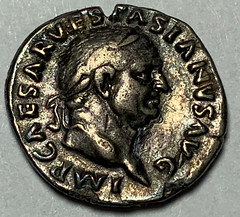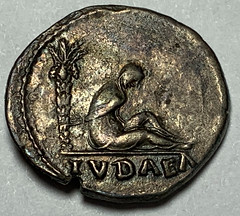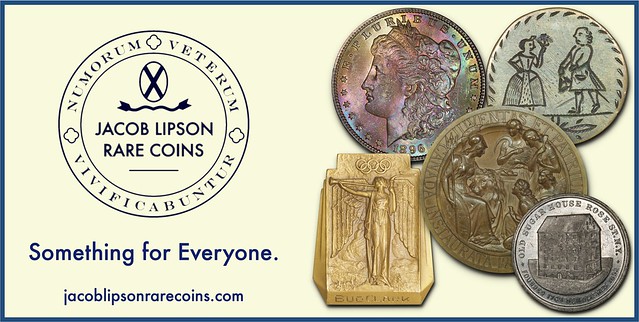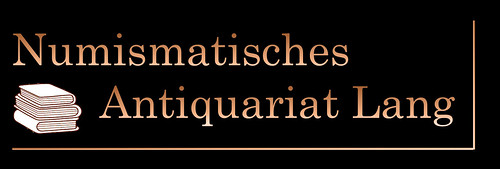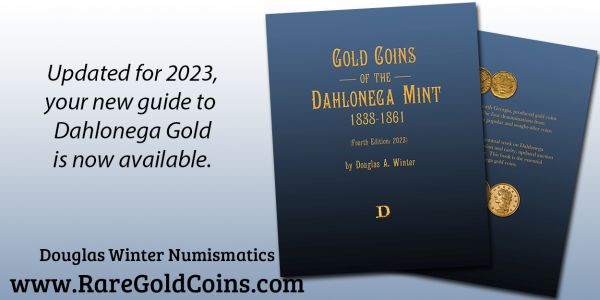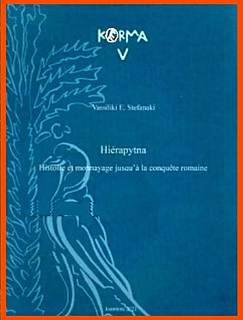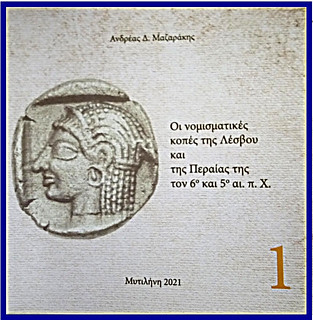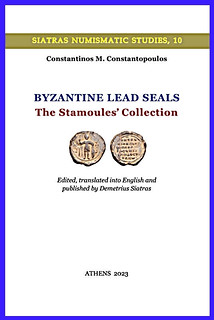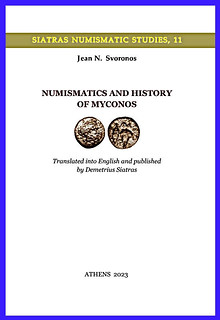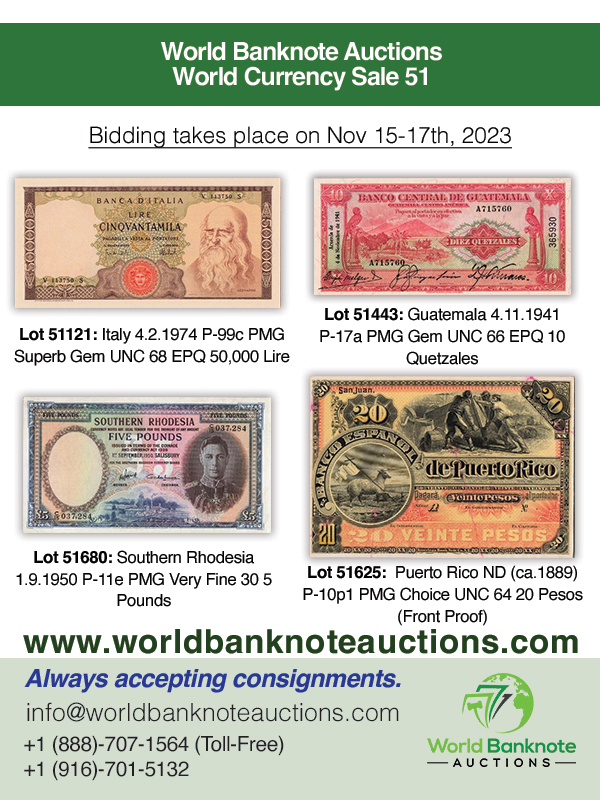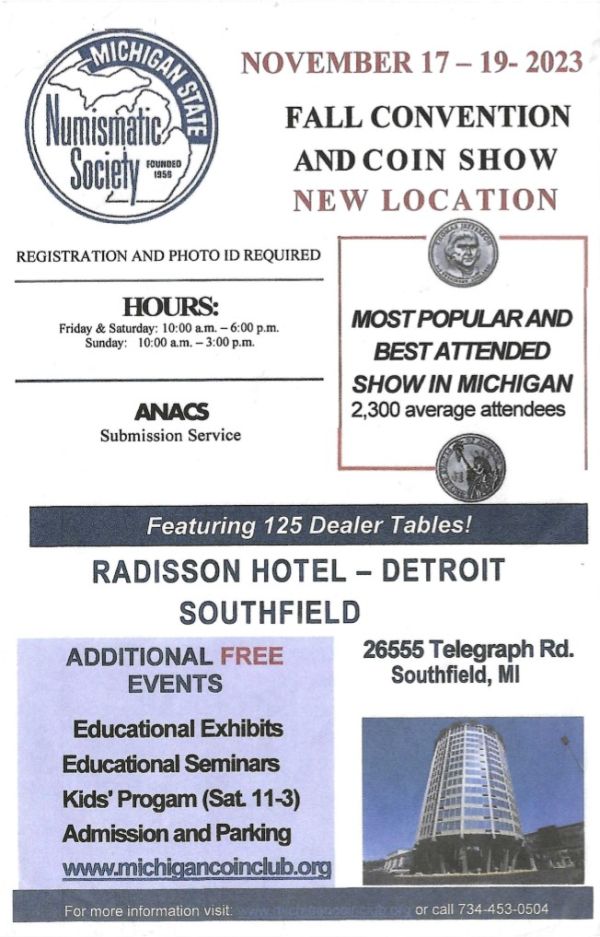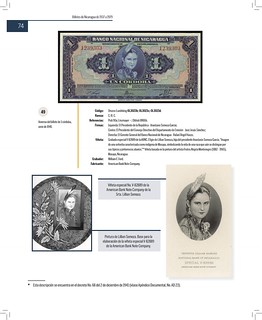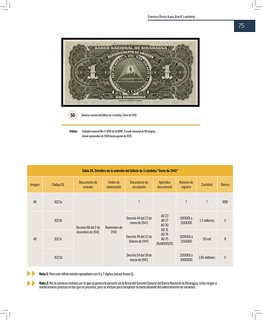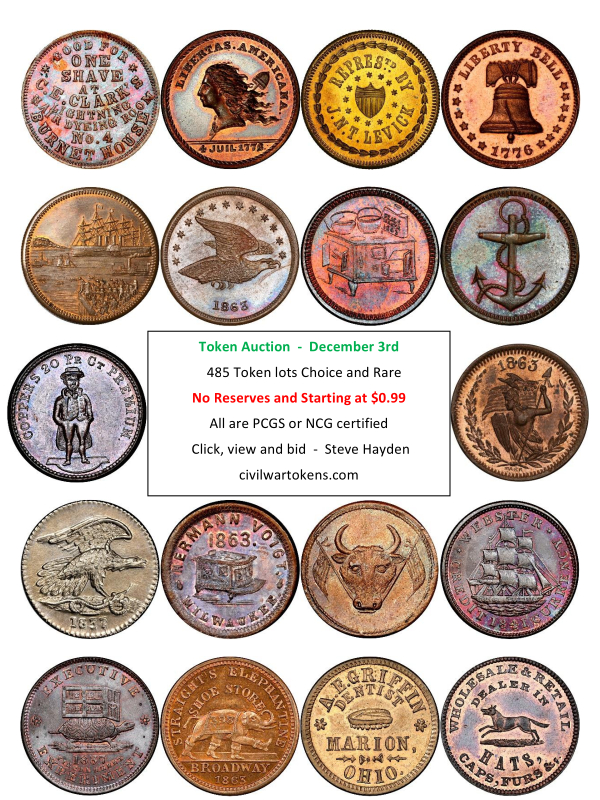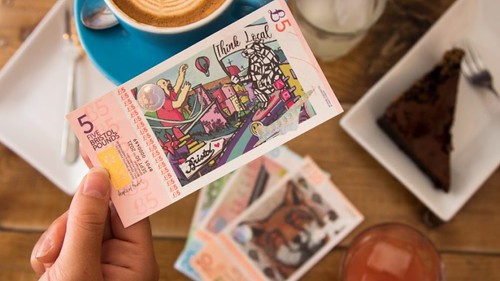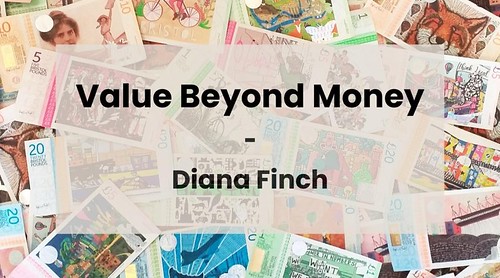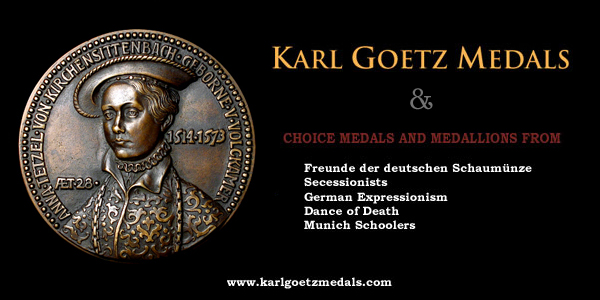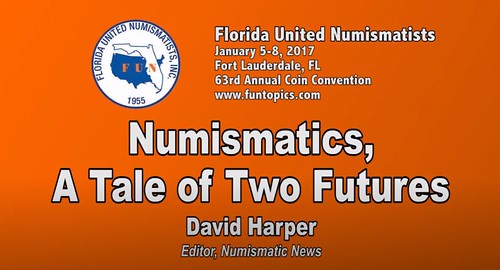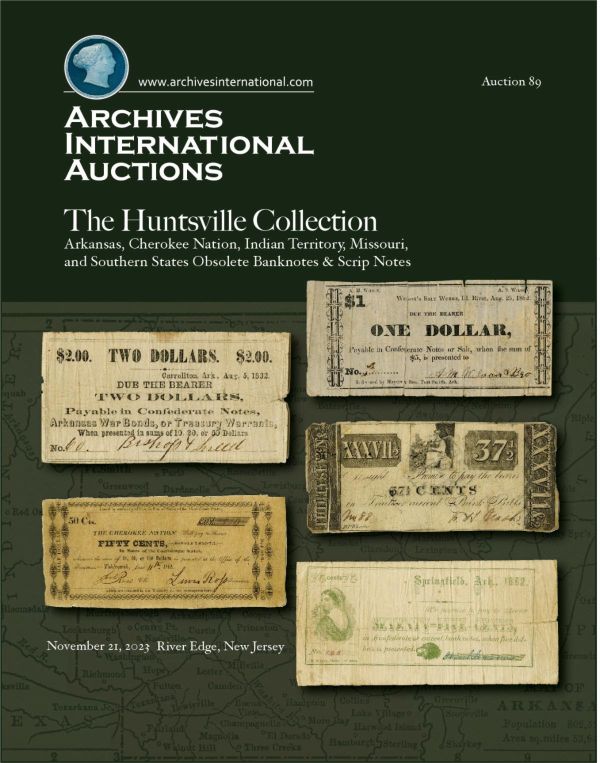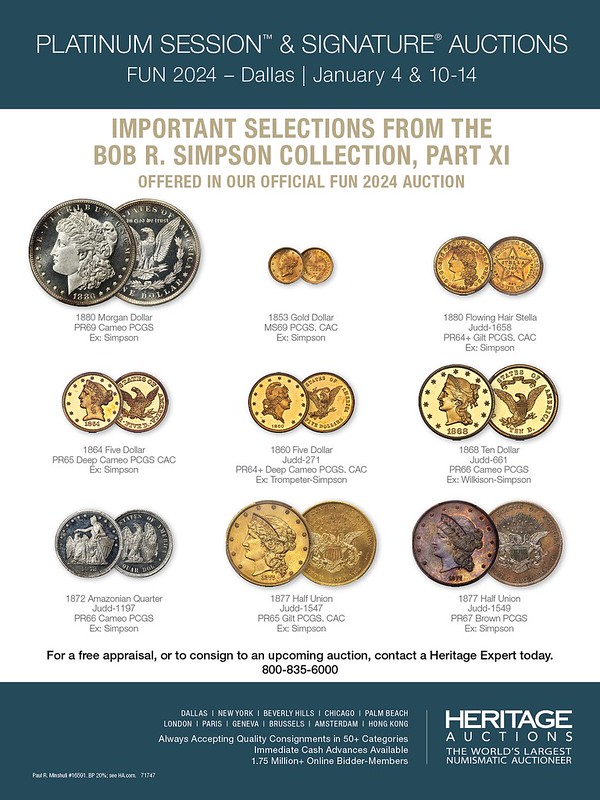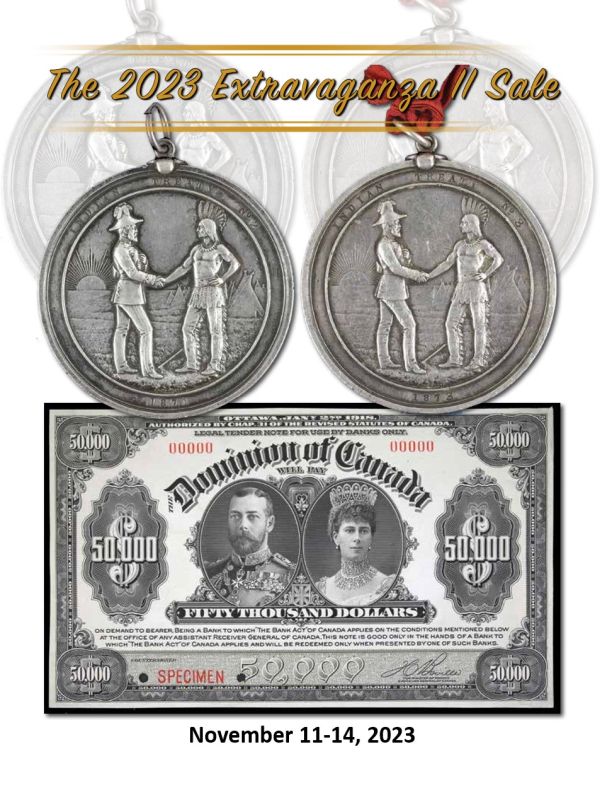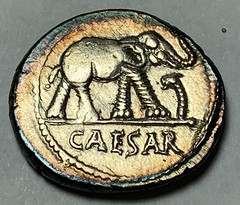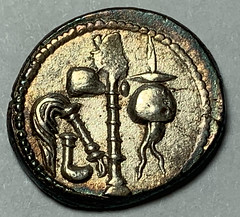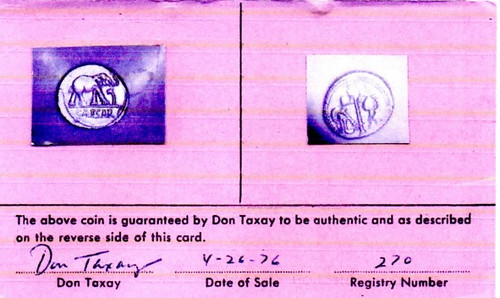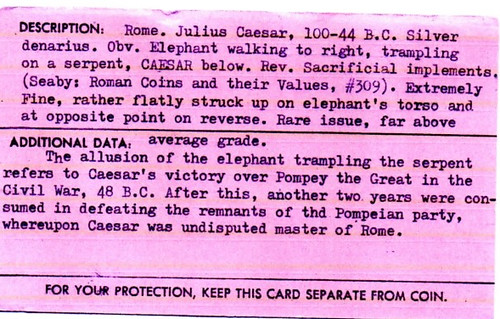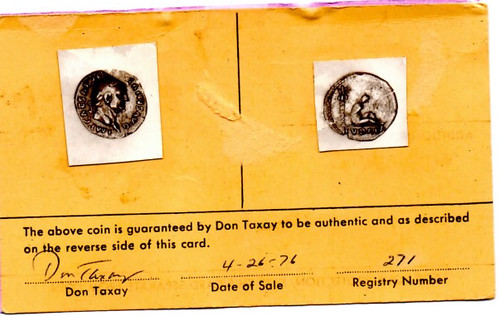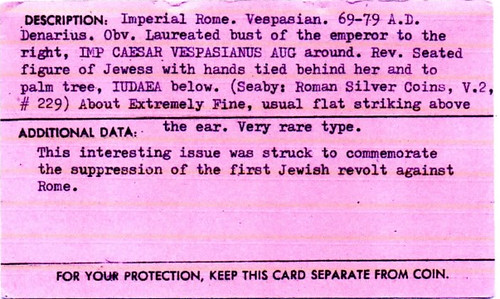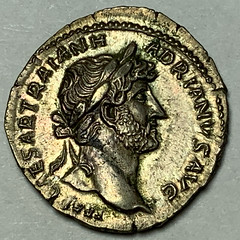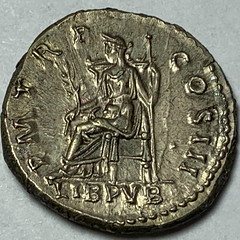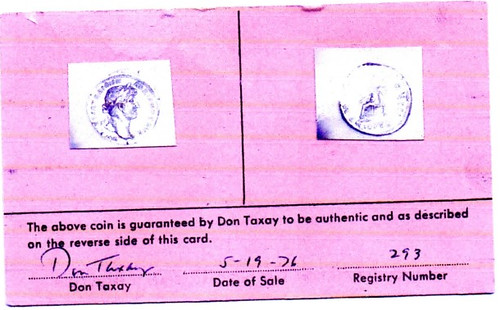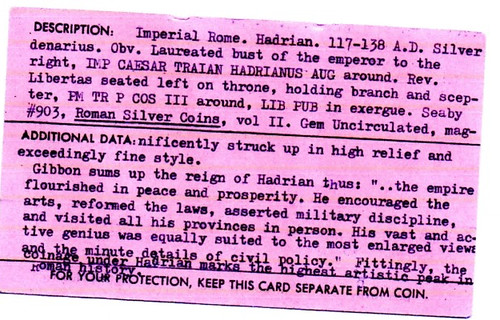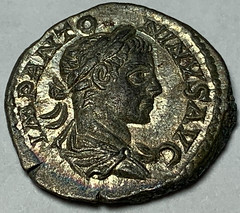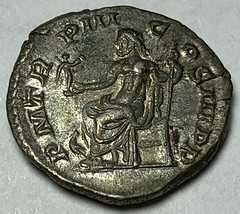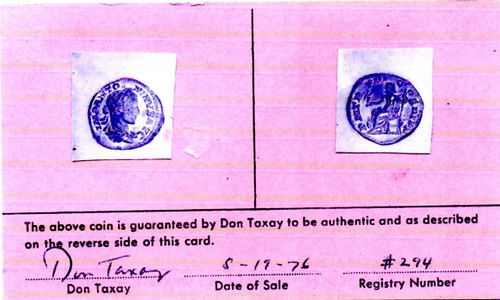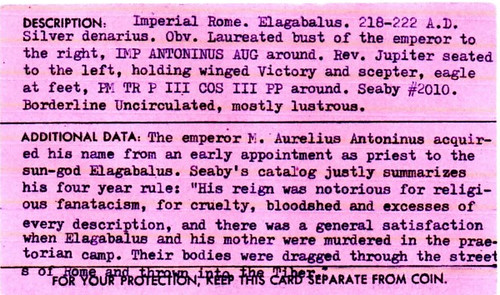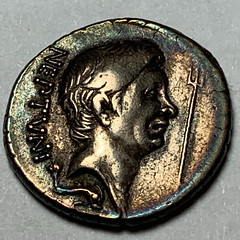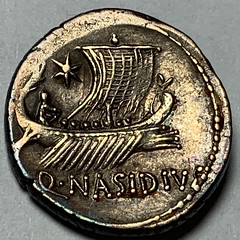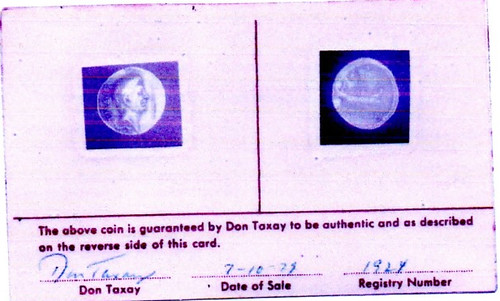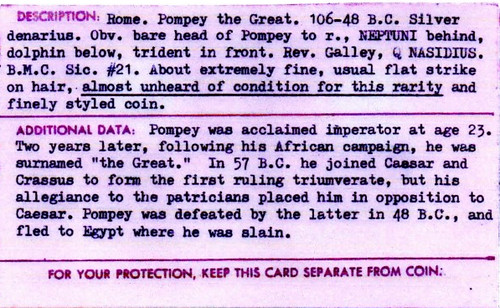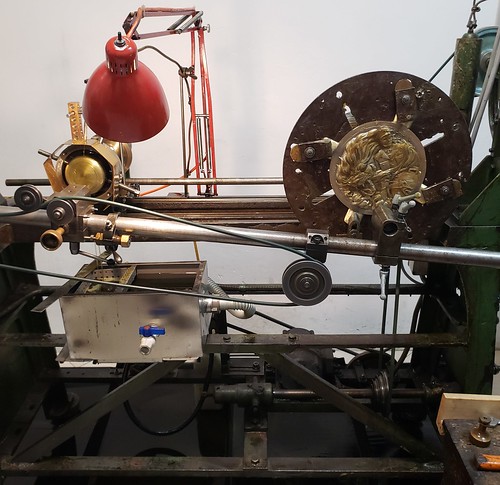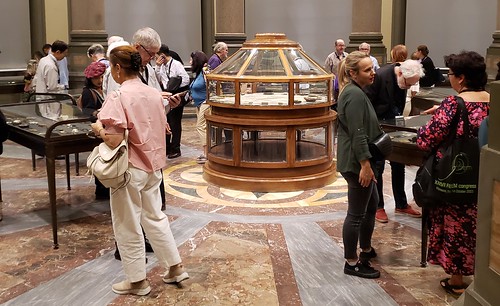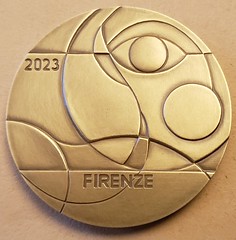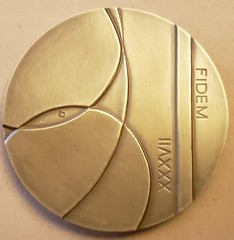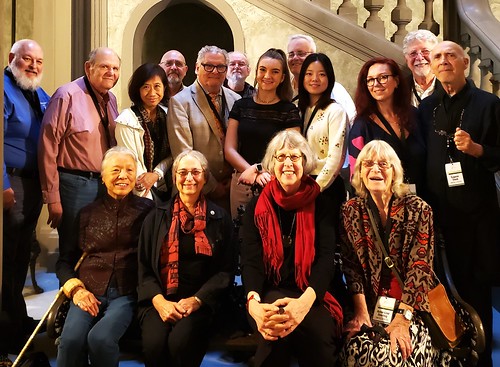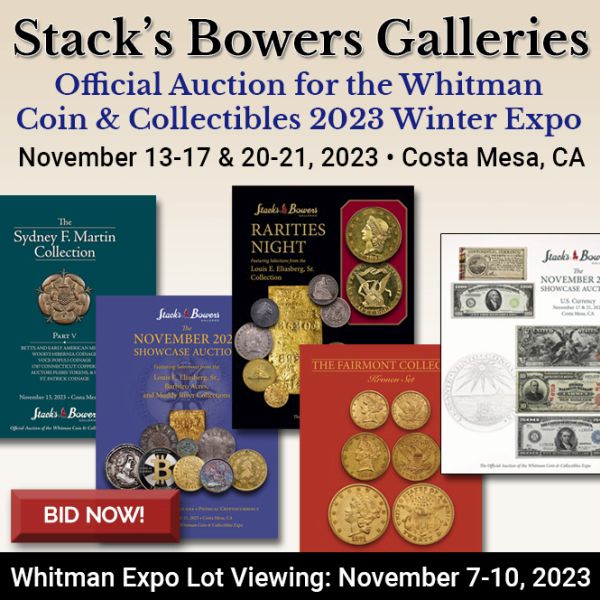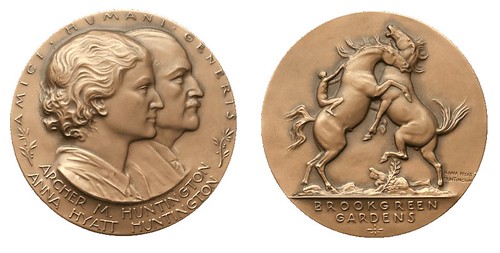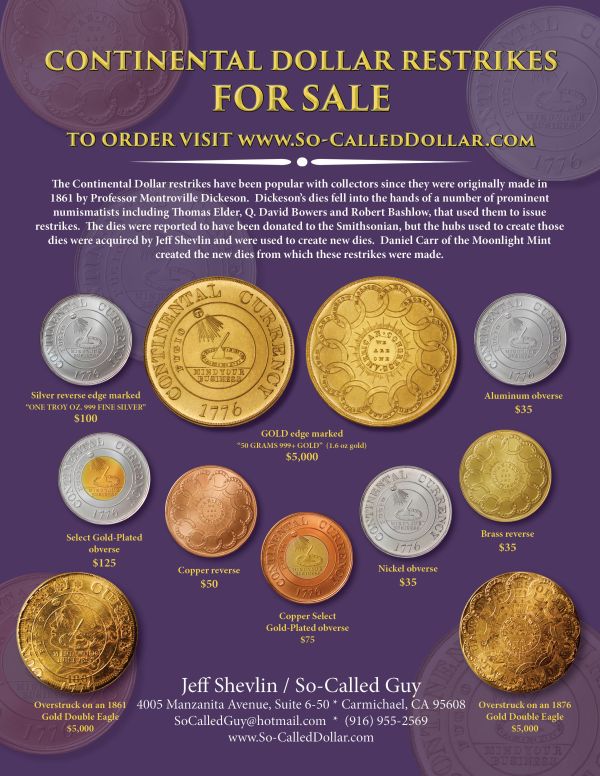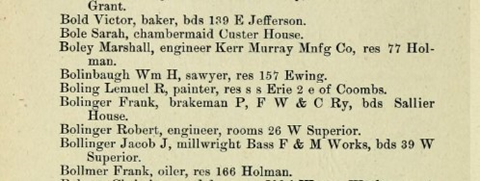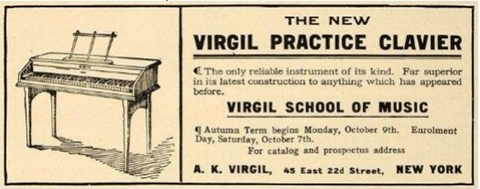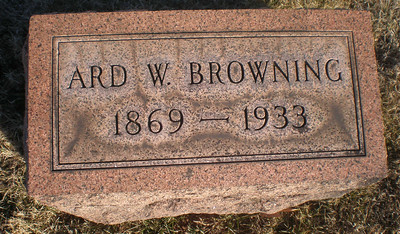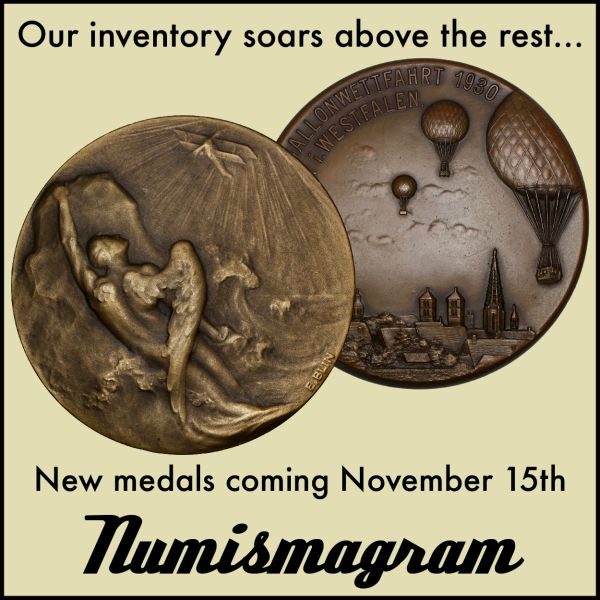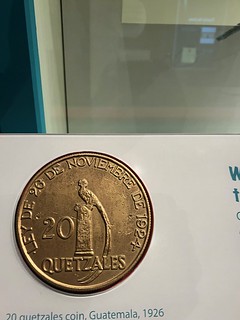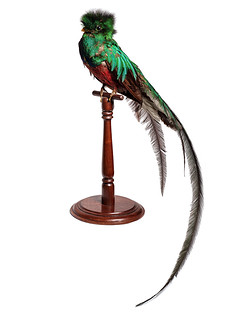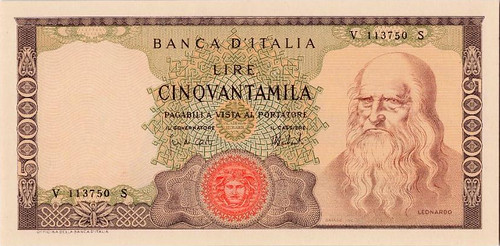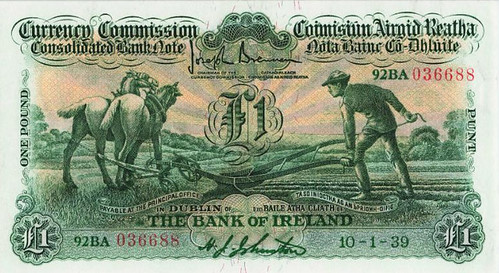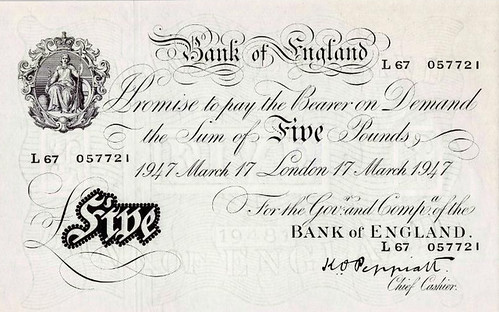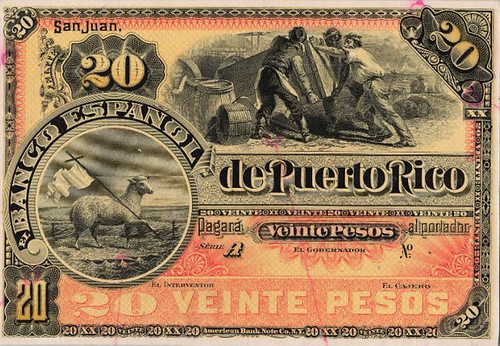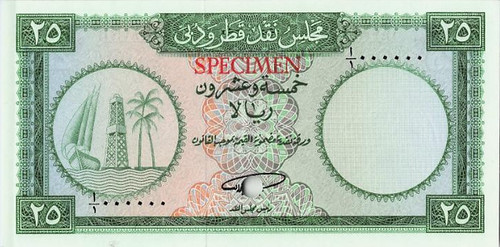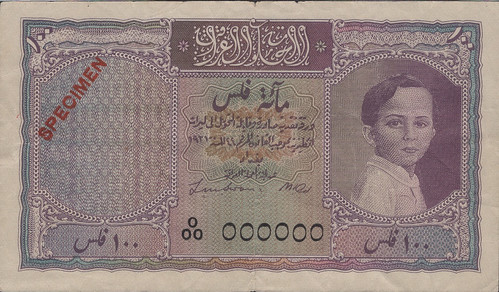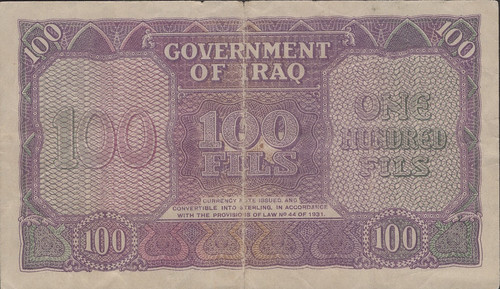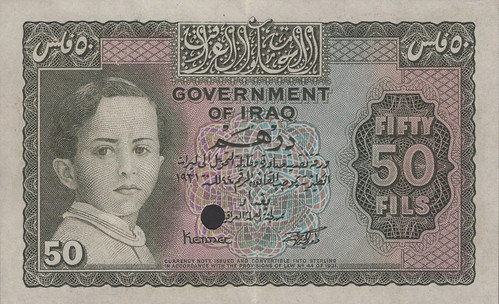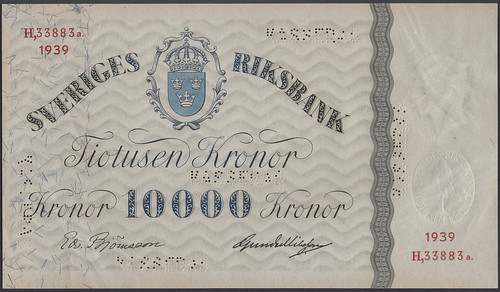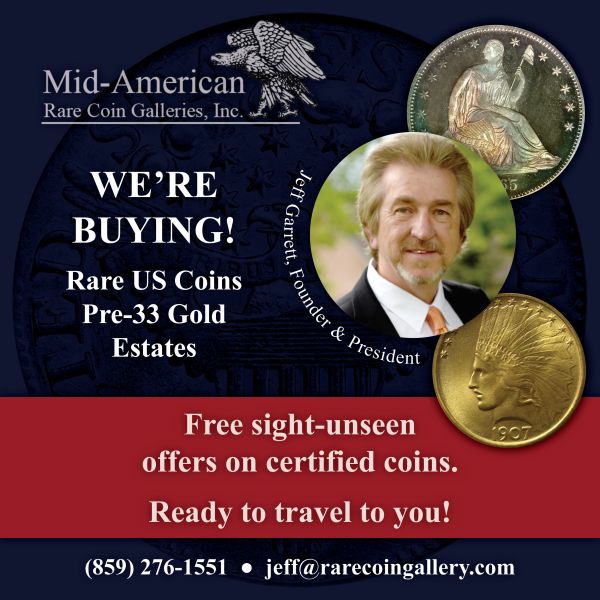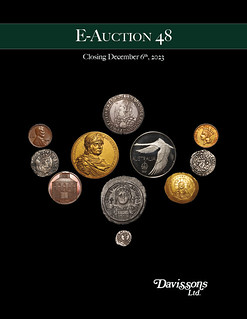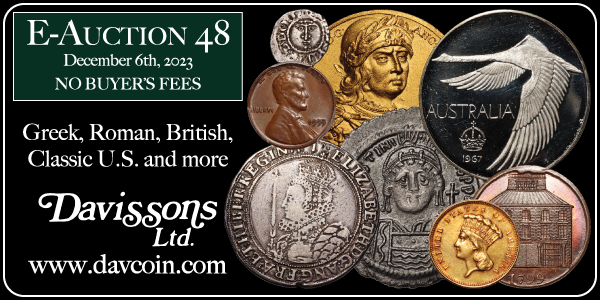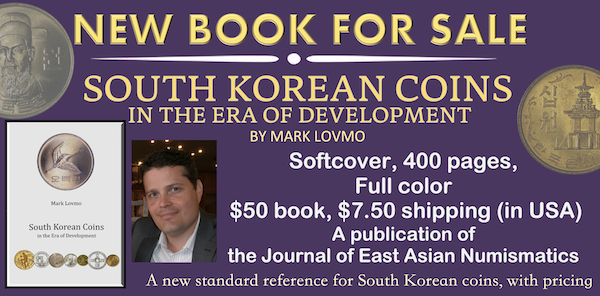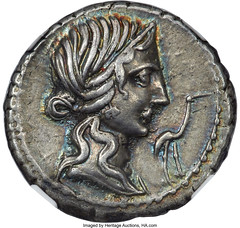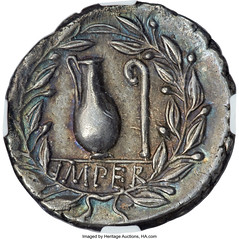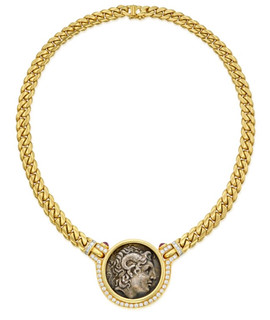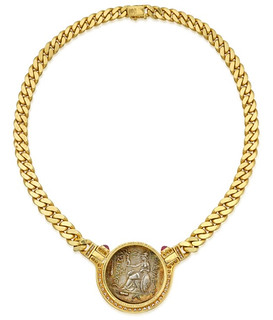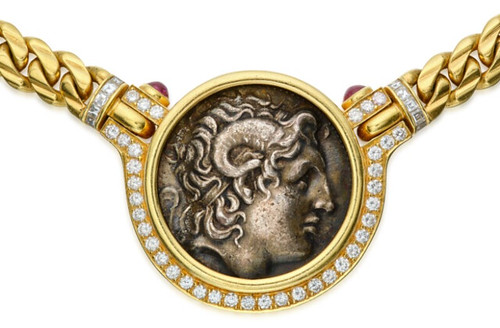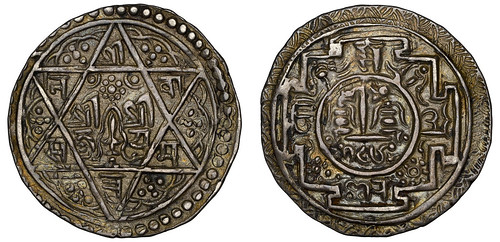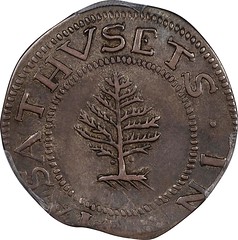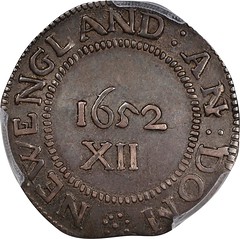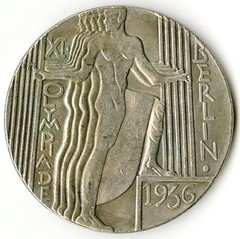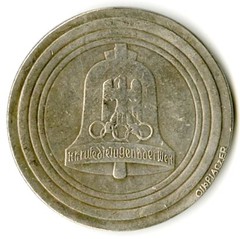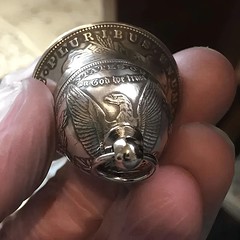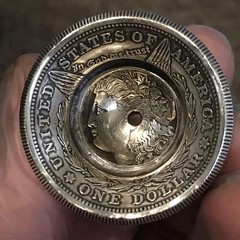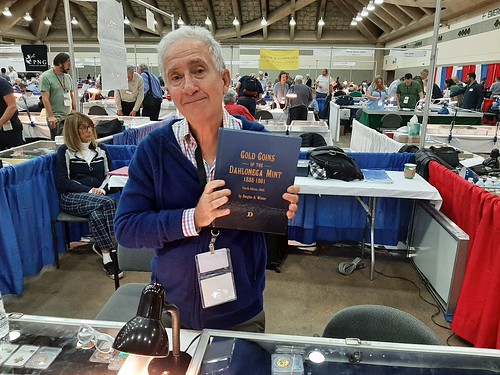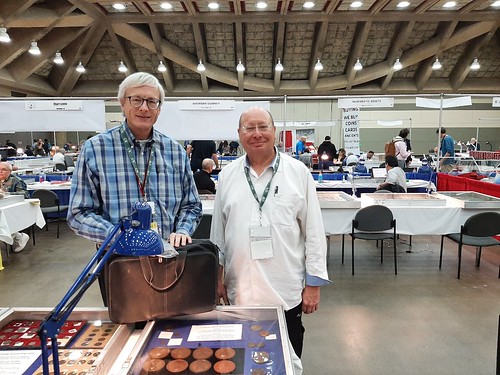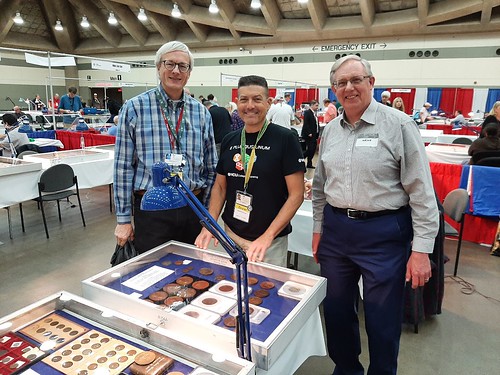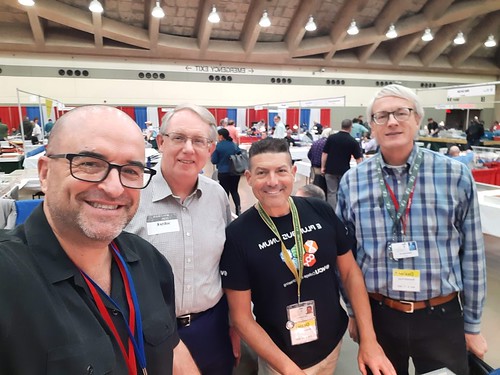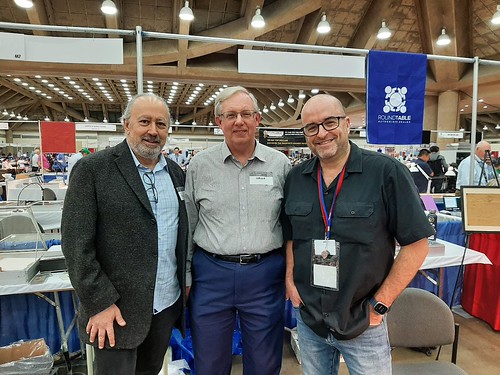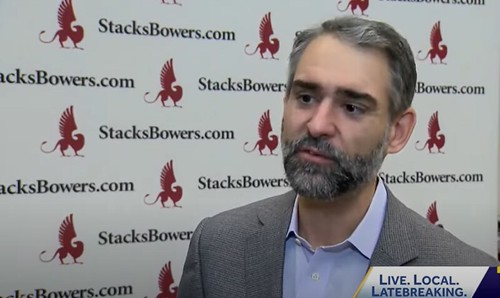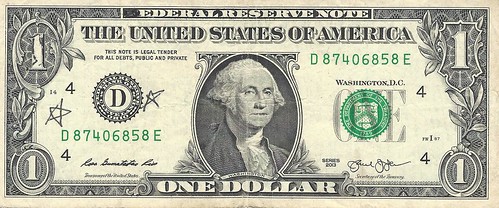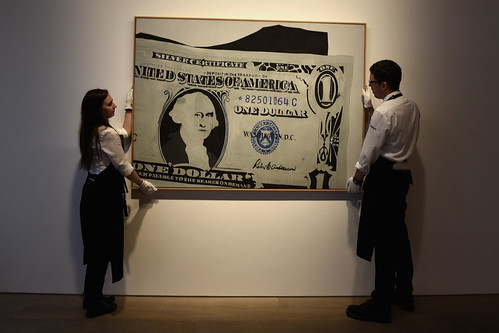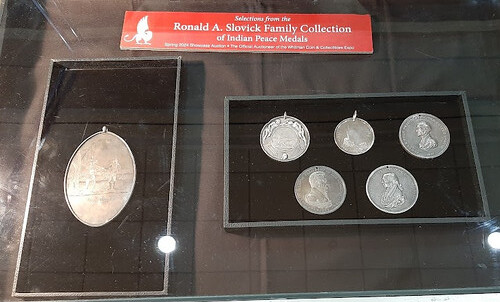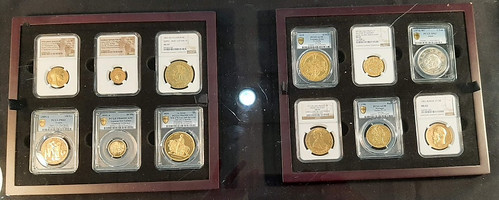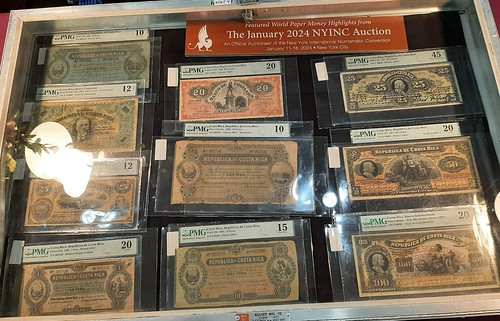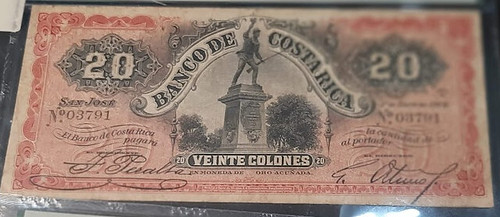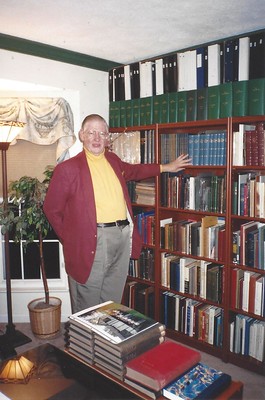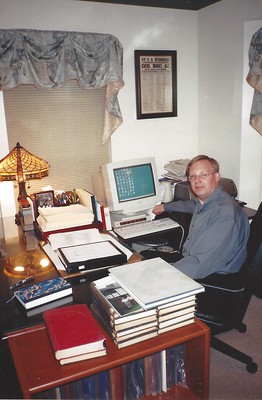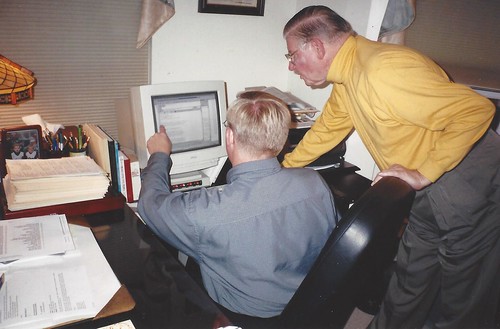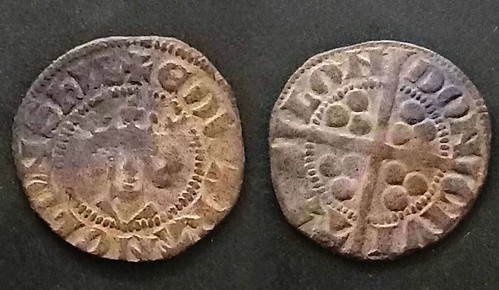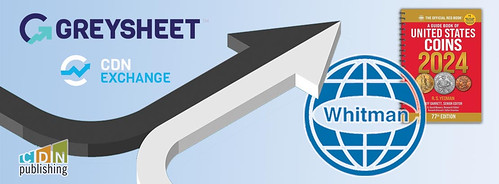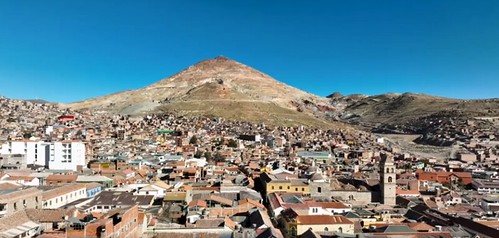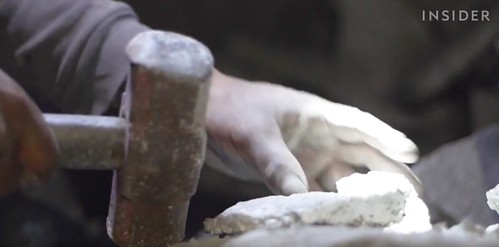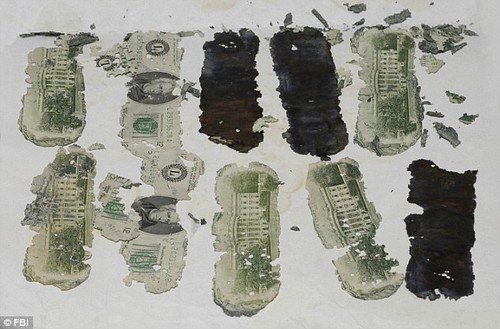
Visit our NBS Sponsors
About UsThe Numismatic Bibliomania Society is a non-profit association devoted to the study and enjoyment of numismatic literature. For more information please see our web site at coinbooks.org SubscriptionsThose wishing to become new E-Sylum subscribers (or wishing to Unsubscribe) can go to the following web page link MembershipThere is a membership application available on the web site Membership Application To join, print the application and return it with your check to the address printed on the application. Print/Digital membership is $40 to addresses in the U.S., and $60 elsewhere. A digital-only membership is available for $25. For those without web access, write to: Jeff Dickerson, Treasurer AsylumFor Asylum mailing address changes and other membership questions, contact Jeff at this email address: treasurer@coinbooks.org SubmissionsTo submit items for publication in The E-Sylum, write to the Editor at this address: whomren@gmail.com BUY THE BOOK BEFORE THE COINSale Calendar |
- WAYNE'S WORDS: THE E-SYLUM NOVEMBER 12, 2023
- GEORGE KOLBE RETIRES FROM BOOKSELLING
- NUMISMATISCHES ANTIQUARIAT LANG LAUNCHES
- NEW TITLES FROM SIATRAS BOOKS
- NEW CHAPTER: NEW ZEALAND MEDALS - 1900S
- NEW BOOK: BILLETES DE NICARAGUA 1937-1979
- NEW BOOK: VALUE BEYOND MONEY
- MORE ON MINIATURE NUMISMATIC BOOKS
- VIDEO: A TALE OF TWO NUMISMATIC FUTURES
- MICHIGAN STATE SHOW NOVEMBER 17-19, 2023
- KUWAIT'S POLICING OF COUNTERFEIT GOLD
- TAXAY CERTIFICATES OF AUTHENTICITY
- XXXVII FIDEM 2023, FLORENCE, ITALY
- VOCABULARY TERM: ORIENTATION
- STILL MORE ON ARD BROWNING
- DAVID SCHENKMAN INTERVIEW, PART TWO
- EXHIBIT REVIEW: REALLY BIG MONEY
- ANA MONEY MUSEUM RECEIVES AWARD
- WBNA WORLD CURRENCY SALE 51
- NOONAN'S NOVEMBER 2023 WORLD BANKNOTES
- DAVISSONS E-AUCTION 48
- NUMISMATIC NUGGETS: NOVEMBER 12, 2023
- WAYNE'S NUMISMATIC DIARY: NOVEMBER 12, 2023, PART 1
- WAYNE'S NUMISMATIC DIARY: NOVEMBER 12, 2023, PART 2
- ANGLESEY METAL DETECTORIST INTERVIEWED
- DEALER WHO EXPOSED BRITISH MUSEUM THEFTS
- LOOSE CHANGE: NOVEMBER 12, 2023
Content presented in The E-Sylum is not necessarily researched or independently fact-checked, and views expressed do not necessarily represent those of the Numismatic Bibliomania Society.
WAYNE'S WORDS: THE E-SYLUM NOVEMBER 12, 2023
 New subscribers this week include:
Julius P. Heitz, and
Frank Szely.
Welcome aboard!
New subscribers this week include:
Julius P. Heitz, and
Frank Szely.
Welcome aboard!
Several readers noted that the full-issue links were incorrect in last week's short version. Sorry - my fault. I think we're good this time.
Thank you for reading The E-Sylum. If you enjoy it, please send me the email addresses of friends you think may enjoy it as well and I'll send them a subscription. Contact me at whomren@gmail.com anytime regarding your subscription, or questions, comments or suggestions about our content.
This week we open with the retirement of numismatic bookseller George Kolbe, the opening of a new numismatic literature firm, seven new books, updates from the Newman Numismatic Portal, and more.
Other topics this week include Nicaraguan paper money, the Bristol Pound, counterfeit gold, Don Taxay's certificates of authenticity, Smithsonian and ANA numismatic exhibits, auction previews, my Whitman Baltimore Coin Expo diary, metal detecting, and the dealer who exposed thefts at the British Museum.
To learn more about Numismatisches Antiquariat Lang, the coins of Myconos, New Zealand medals, fake slabs, FIDEM, Ard Browning, David Schenkman, Dick Johnson, Taylor Swift, Mary Tyler Moore's Bulgari necklace, a Noe-1 Pine Tree Shilling, Dahlonega gold, and the Adventures of a Halfpenny, read on. Have a great week, everyone!
Wayne Homren
Editor, The E-Sylum
GEORGE KOLBE RETIRES FROM BOOKSELLING
Wow. Numismatic Bibliomania Society co-founder and longtime numismatic literature dealer George Kolbe is retiring, and I'm speechless except to say it's well deserved - good luck, have fun, and keep in touch! Here's the press release. -Editor
GEORGE KOLBE RETIRES FROM BOOKSELLING
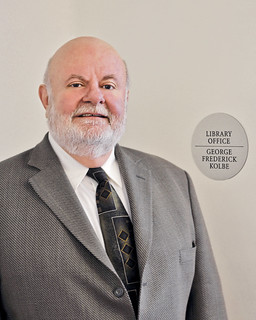 George Frederick Kolbe, numismatic bookseller and author, has announced his retirement from
the partnership of Kolbe & Fanning Numismatic Booksellers. The firm will continue to operate
as Kolbe & Fanning under the ownership of David and Maria Fanning and will remain in their
Gahanna, Ohio offices.
George Frederick Kolbe, numismatic bookseller and author, has announced his retirement from
the partnership of Kolbe & Fanning Numismatic Booksellers. The firm will continue to operate
as Kolbe & Fanning under the ownership of David and Maria Fanning and will remain in their
Gahanna, Ohio offices.
Kolbe began his career as a numismatic bookseller in May 1967 with the publication of his first fixed price list, a three-page typewritten compilation sent from Redondo Beach, California, to no more than two dozen potential customers. Subsequent lists grew in sophistication both of content and format, and in 1976 Kolbe (by now in Mission Viejo) held his first auction, a mail- bid sale of 763 lots. Three subsequent mail-bid sales were followed by Kolbe's first public auction, held in conjunction with the 1979 Convention of International Numismatics in Los Angeles.
To date, George Kolbe has been associated with some 168 auctions conducted under his name or (beginning in 2010) under the Kolbe & Fanning banner. Many of these sale catalogues function as references within the field of numismatic literature. A listing of notable libraries sold over the years would consist of too many names to include here, though the Harry W. Bass, John J. Ford, and Stack Family libraries require particular mention, as do the fifteen New York auctions conducted jointly with Douglas Saville of Spink. During his career, Kolbe also published The Numismatic Bookseller, which variably functioned as a house organ, fixed price list, and mail-bid sale, and founded the Numismatic Bibliomania Society with his friend Jack Collins. In 2012, Kolbe published a bibliography, The Reference Library of a Numismatic Bookseller, based on his personal working library.
David Fanning writes, When Kolbe & Fanning was established in 2010, it was a great honor for
me to join forces with the preeminent numismatic bookseller of our day. As our partnership is
ending and our firm prepares to move forward on our own, it is our honor to do so with the
Kolbe name firmly attached. We are enormously grateful to George for providing us with the
opportunity to go into business with him, and we send our very best wishes with him into his
well-earned retirement.
Kolbe & Fanning Numismatic Booksellers will be holding their next auction on February 17, 2024, when they will be offering highlights from the extraordinary BCD Library on ancient numismatics. The firm's website will remain at numislit.com.
NUMISMATISCHES ANTIQUARIAT LANG LAUNCHES
A new numismatic literature firm has been launched in Germany. Numismatisches Antiquariat Lang will offer its first auction sale in January 2024. Here's some information from their website, where you can sign up for their email newsletter. -Editor
We, Michael Lang and Alexander Riesner, are the Numismatic Antiquariat Lang . Newly founded in February 2023. We are an auction house specializing in numismatic literature and offer collectors and researchers a wide range of both rare and unique treasures as well as standard works from the world of numismatic literature. Based on a long-standing partnership with Solidus Numismatik, we are the German auction house specializing in numismatic literature.
Our goal is to promote enthusiasm for numismatics and to make numismatic literature accessible. We will therefore delight you with new auctions at regular intervals. If you can't find what you're looking for, please contact us at any time.
We look forward to many more auctions with you.
Exclusively at CoinsWeekly you will find our offer from our first stock list. Together with an article that briefly introduces us and the newly founded auction house.
To view their first fixed price list, see:
Numismatisches Antiquariat Lang Stock List 1 Literature
(https://new.coinsweekly.com/auctions/fixed-price-offers/numismatisches-antiquariat-lang/)
To visit the firm's website, see:
https://www.numismatisches-antiquariat.de/
To view their auction, see:
https://www.numismatisches-antiquariat.de/AUKTIONEN/
To read a CoinsWeekly article, see:
A New Chapter: The Foundation of a New Auction House for Numismatic Literature
(https://new.coinsweekly.com/news-en/a-new-chapter-the-foundation-of-a-new-auction-house-for-numismatic-literature/)
NEW TITLES FROM SIATRAS BOOKS
Demetrius Siatras writes:
We announce four new titles on numismatics, recently released:
- the fifth volume of the KERMA Series, dealing with the coinage of Hierapytna;
- the study of A. Mazarakis on Lesbos' coins of the 6th and 5th ce, BC (in Greek);
- the English translation of the Stamoules' collection of Byzantine lead seals.
- the English translation of Svoronos' treatise on the coinage of Myconos;
Here are some more details. Follow the link below to order. -Editor
KERMA V: Hiérapytna – Histoire et monnayage jusqu'à la conquête romaine
by V.E. Stefanaki
In French. Soft cover, 29 cm, 524 pp.; net weight 2080 gr. ISBN: 978-960-88985-3-0.
Hoi nomismatikes kopes tes Lesvou kai tes Peraias tes ton 6o kai 5o ai. p. Ch.
[The Numismatic Issues of Lesbos and its Peraea During the 6th and 5th Centuries BC]
by Andreas D. Mazarakis
In Greek. Soft cover, 24x24 cm, 112 pp., ill. (partly in colour). ISBN: 978-960-85178-2-0.
Byzantine Lead Seals - The Stamoules' Collection
by C.M. Constantopoulos
Athens, 2023. In English. Soft cover, 24 cm, 108 pp., ill.: 10 B/W plates with seals. ISBN: 978-618-5818-00-5.
NUMISMATICS AND HISTORY OF MYCONOS
by Jean Svoronos
In English. Soft cover, 24 cm, 80 pp., ill. ISBN: 978-618-5818-01-2. Presents the coins of Myconos from 394 BC to 14 AD. Special reference to the wrong attributions of other authors. Includes the coins struck in the nearby islands of Tenos and Delos.
For more information, or to order, see:
https://www.biblio.com/bookstore/demetrius-siatras-athens/numismatics/
NEW CHAPTER: NEW ZEALAND MEDALS - 1900S
A further digital chapter has been released in the progressive update to Leon Morel's catalogue of NZ Commemorative Medals prior to 1940. Thanks to Martin Purdy of Upper Hutt, New Zealand for passing this information along. -Editor
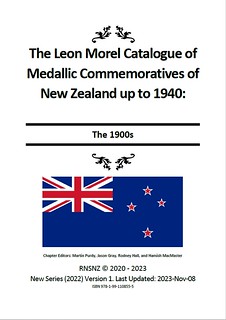 This is part of a projected multi-volume series updating Leon Morel's Catalogue of Medallic Commemoratives of New Zealand, 1865-1940 (1996) and the Supplement published in 2000. This new edition marks a departure from previous RNSNZ catalogue projects in that it is being released electronically in the first instance, and in sections. In this way, parts of the book can be published as they become ready, and can also be regularly updated as new information becomes available.
This is part of a projected multi-volume series updating Leon Morel's Catalogue of Medallic Commemoratives of New Zealand, 1865-1940 (1996) and the Supplement published in 2000. This new edition marks a departure from previous RNSNZ catalogue projects in that it is being released electronically in the first instance, and in sections. In this way, parts of the book can be published as they become ready, and can also be regularly updated as new information becomes available.
The various sections of the catalogue will ultimately cover the whole of NZ's medallic history from the earliest issues associated with this country through to the Centennial events of 1940. More recent issues, from 1940 (not Centennial-related) to date, are being covered by a companion series, New Zealand Commemorative Medals since 1940, which is also being published in parts and in electronic form.
Because these publications are being released as searchable PDFs, the previous Index of Legends has now been dispensed with as unnecessary.
To access the chapters online, see:
https://www.rnsnz.org.nz/collector-info/catalogues
or
https://archive.org/details/@james_tigernuts
To read the earlier E-Sylum articles, see:
NEW BOOK: NEW ZEALAND MEDALS 1939-40
(https://www.coinbooks.org/v23/esylum_v23n36a05.html)
NEW CHAPTERS: NEW ZEALAND MEDALS 1920S-30S
(https://www.coinbooks.org/v24/esylum_v24n50a04.html)
NEW CHAPTERS: NEW ZEALAND MEDALS 1939-40, 2020S
(https://www.coinbooks.org/v24/esylum_v24n52a04.html)
NEW BOOK: BILLETES DE NICARAGUA 1937-1979
Alan Luedeking submitted this announcement of his new book with co-author Francisco Orozco Icaza on the paper money of Nicaragua. Thank you, and congratulations! -Editor
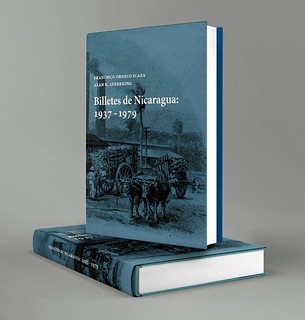 On behalf of my co-author, Francisco Orozco Icaza and myself, we are pleased to present a new work on Nicaraguan numismatics, Billetes de Nicaragua 1937-1979. It is the first of four volumes we have in mind, dividing the corpus of Nicaraguan paper money issues into its four principal periods.
On behalf of my co-author, Francisco Orozco Icaza and myself, we are pleased to present a new work on Nicaraguan numismatics, Billetes de Nicaragua 1937-1979. It is the first of four volumes we have in mind, dividing the corpus of Nicaraguan paper money issues into its four principal periods.
The present work covers the issues from 1937 to 1979, basically from the beginning of the Somoza dynasty until the fall of the Somoza regime in 1979. Choosing to begin with this date range came naturally because it represents the most stable period in Nicaragua's financial history, with the best availability of reliable documentation, and with excellent availability of banknotes in collections to illustrate the work.
We begin with the authors' Acknowledgements, among whom I would like to highlight Davide Oldrati in Italy for his magnificent work of researching, cataloging, and illustrating signatures on banknotes from many Latin American countries, and whose work on Nicaraguan banknote signatures is extensive and excellent. We are also indebted to the distinguished researcher of engraving art and vignette history, Mark D. Tomasko, whose several books on the subject and direct contributions helped us a lot.
The Introduction to the work discusses its purpose and the documentation that we were able to compile. These documentary sources are transcribed in their entirety and are of primary importance as they allow us to present for the first time a detailed catalogue of the notes issued for the period in question. These are grouped by the year of issue corresponding to their authorization decrees, then sorted by denomination in ascending order.
Each type or issue is assigned a carefully crafted reference code specific to this work. With this numbering system, a banknote can be identified in much greater detail than with the simple Pick number that appears in the Krause Publications' catalogs. This in turn gives us the flexibility to assign a much more accurate and precise rarity grade to each type and variety.
Although no commercial values are assigned, given their volatility, a Rarity Table with precise rarity ratings provides a more robust tool to estimate them in general, since a Nicaraguan note of this period classified as Very Rare (RR) or Extremely Rare (RRR) will likely always fetch a very high price at auction.
The image of the best-known issued example for each year and denomination and principal variety is presented where possible; on rare occasions where no issued example can be located, a specimen note is plated, as in the case of the 1937 50 Córdobas, for instance. In some rare instances there is no image at all, when the banknote is totally unknown in any collection or archive. In these exceptional circumstances, we leave a box with a space in case the banknote appears in the future; then the owner of the book can cut out a photograph of the note and paste it in.
At the end of each section, we present a table summarizing every note's relevant information for that type and denomination, including serial number ranges and rarities. At the end of each chapter, we present a summary table with the information for all the denominations of that series. These in turn are summarized in a large table at the end of the book. In our opinion, these tables form the heart of the work and represent the distillation of all our knowledge of these banknotes, especially their rarities.
The Documentary Appendix presents a faithful transcription of all the documents referred to in the tables, duly numbered. The reader can verify the details of each issue for him- or herself. This appendix represents the bulk of the work and makes the book a worthy study tool.
The book is also embellished with information about many of the vignettes that appear on the banknotes and the art that originated them. A Glossary, Index and Bibliography complete the work, which is entirely in Spanish. The book is printed on high quality paper, 474 pages long, and bound in hardcovers with a dustjacket.
The book may be purchased directly from the authors for $350 plus $25 shipping via UPS within the USA (it is a heavy book!) Shipments to Europe are prohibitive (roughly $200 via DHL.) Please contact Alan Luedeking at alan@ludeca.com for orders within the USA, or Francisco Orozco at orozcoicaz@gmail.com for orders within Nicaragua.
NEW BOOK: VALUE BEYOND MONEY
A new book is in the works about the famed Bristol Pound. Found via News & Notes from the Society of Paper Money Collectors (Volume IX, Number 21, November 7, 2023) -Editor
A new book called Value Beyond Money promises to tell the full story
of the failed Bristol Pound experiment.
The Bristol Pound, which was launched with great fanfare in 2012 and lasted until 2021, was the first local currency to have digital and paper money from the outset, and the first to enable the payment of local taxes in the local currency, with former Bristol mayor George Ferguson even accepting his entire salary in Bristol Pounds.
Its aim was to raise awareness of the importance of localisation of trade, building community wealth by trapping money in the local economy, but to its detractors it was no more than a glorified voucher system.
Value Beyond Money author Diana Finch, former managing director of the Bristol Pound, says that her book is an antidote to normal books about money and economics
.
A crowdfunder is running throughout November to raise money for the book being published by charity publisher Arkbound Foundation.
To read the complete article, see:
NEW BOOK TO TELL ‘FULL STORY' OF THE BRISTOL POUND
(https://www.bristol247.com/culture/books/new-book-tell-full-story-bristol-pound/)
Here's some information from the crowdfunding site. -Editor
Books about money and economics are not obvious cases for crowdfunding support. However, this one is an antidote to normal books about money and economics. It contains absolutely no ideas for how to make us richer in financial terms, and is unlikely to be welcomed by anybody who gains from the current economic system! As such, it would be pretty much impossible to get the book published by any commercial publisher. Yet, the ideas explored in Value Beyond Money are very important if we are to create a socially just world in which Earth's resources are shared fairly and managed with concern for the long-term future of human and other life.
This campaign seeks to make Value Beyond Money become a reality. By contributing, you can also access a range of different rewards. Thank you!
The Book
Value Beyond Money takes the reader on a journey through many of the ideas behind new or alternative economic thinking, via Diana's experience of working on the Bristol Pound local currency project. The book assumes no prior knowledge about economics, new economics or anything else for that matter, and is an ideal starting point for anyone who is beginning to wonder whether just a bit more economic growth really will solve all our problems.
The Author
Diana Finch has been working in senior leadership roles in the non-profit sector for over twenty years. Through this work, she became increasingly convinced that the economic system itself was the cause of many of the environmental and social challenges she was trying to address. She had the opportunity to join the Bristol Pound team as Managing Director in 2018 and continued to lead the company until it closed its doors for the last time earlier this year. This experience helped her develop her understanding of the problems with our existing economic system, and made her determined to share what she has learned as widely as possible by writing this book.
For more information, or to order, see:
Value Beyond Money
(https://crowdbound.org/product/value-beyond-money/)
THE BOOK BAZARRE
a personal repository for the actual holy grail documents of great reputeand says,
I would recommend that everybody pay attention to him.Rendell's memoir Safeguarding History is the perfect holiday gift for a coin collector or history buff. Order your copy online (including at Whitman.com ), or call 1-800-546-2995.
MORE ON MINIATURE NUMISMATIC BOOKS
Newman Numismatic Portal Project Coordinator Len Augsburger provided the following report on miniature numismatic books. Thank you. -Editor
More on Miniature Numismatic Books
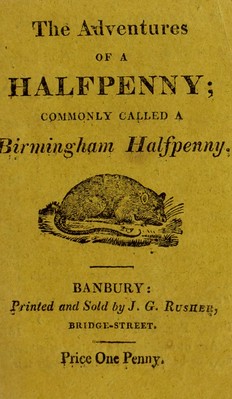 Following up on the E-Sylum note of November 5 discussing miniature books, it's worth noting that Julian Edison (1929-2017), a brother-in-law of Eric P. Newman, was among the foremost collectors of miniature books. Today, Washington University in St. Louis holds a group of over 3,500 miniature books from the Julian and Hope Edison Collection, a selection of which is currently on exhibit at Olin Library. Another group from the Edison collection was donated to the Houghton Library at Harvard University in 2019.
Following up on the E-Sylum note of November 5 discussing miniature books, it's worth noting that Julian Edison (1929-2017), a brother-in-law of Eric P. Newman, was among the foremost collectors of miniature books. Today, Washington University in St. Louis holds a group of over 3,500 miniature books from the Julian and Hope Edison Collection, a selection of which is currently on exhibit at Olin Library. Another group from the Edison collection was donated to the Houghton Library at Harvard University in 2019.
The Newman library sale (Heritage Auctions, November 2018) included a copy of the miniature Adventures of a Halfpenny, a moral tale for children decrying the adulteration of copper coins. The work was marketed along with a series of little books
aimed at children. This volume was reprinted in the August 1997 Colonial Newsletter with annotations by Charles W. Smith, and further discussed by Andrew Wager in the Conder Token Collector's Journal in March 2000. The Newman copy sold for $456 on November 7, 2018.
Image: Front cover of Adventures of a Halfpenny, c. 1830.
Link to Newman copy of Adventures of a Halfpenny
https://archive.org/details/adventuresofhalf1830john
Link to August 1997 Colonial Newsletter:
https://archive.org/details/CNLno105
Link to March 2000 Conder Token Collector's Journal:
https://archive.org/details/CTCJournal15
To read the earlier E-Sylum article, see:
MINIATURE NUMISMATIC LITERATURE
(https://www.coinbooks.org/v26/esylum_v26n45a16.html)
VIDEO: A TALE OF TWO NUMISMATIC FUTURES
The David Lisot Video Library on the Newman Numismatic Portal can be found at:
https://nnp.wustl.edu/library/multimediadetail/522852
We highlight one of his videos each week in The E-Sylum. Here's one from 2017 with Numismatic News editor Dave Harper speaking about the short and long-term future of numismatics. -Editor
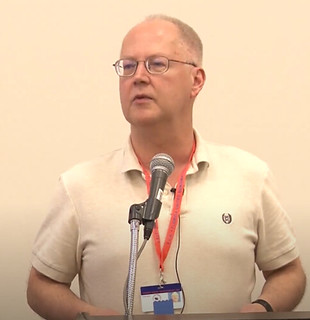 Numismatics: A Tale of Two Futures
Numismatics: A Tale of Two Futures
Mr. Harper, the editor of Numismatic News is known for making an annual forecast concerning the future course of the numismatic and bullion marketplace. Is David's forecast for 2017 full of good news or bad news? Find out in this hard-hitting educational program that will include both a short term and a long term forecast. Speaker: David Harper. Running time: 55:27.
Nearly seven years on, how did Dave do? How would you have done? Anyone care to give us their thoughts on the numismatic future beyond 2023? -Editor
To watch the complete video, see:
https://nnp.wustl.edu/library/book/540310
MICHIGAN STATE SHOW NOVEMBER 17-19, 2023
The Michigan State Numismatic Society Fall Convention is upon us, and there will be a number of interesting topics covered in their educational program. -Editor
MICHIGAN STATE NUMISMATIC SOCIETY TO HOST ANNUAL FALL CONVENTION
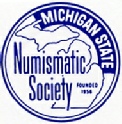 The Michigan State Numismatic Society is excited to share information about its
upcoming convention, held on a new date and in a new location! The dates of the new
show are Friday, Nov. 17-Sunday, Nov. 19 at the Radisson Hotel in Southfield! We
have some excellent speakers presenting all kinds of topics for us, ranging from Notgeld
coins to Fake Slabs and hints for starting a local coin club. Please see the schedule
below.
The Michigan State Numismatic Society is excited to share information about its
upcoming convention, held on a new date and in a new location! The dates of the new
show are Friday, Nov. 17-Sunday, Nov. 19 at the Radisson Hotel in Southfield! We
have some excellent speakers presenting all kinds of topics for us, ranging from Notgeld
coins to Fake Slabs and hints for starting a local coin club. Please see the schedule
below.
We are also excited to be welcoming some new dealers to our show – since it's not on Thanksgiving weekend, new dealers have signed up to come and visit us in the Detroit area! We will also have a great line-up of exhibits for you to view, as well as a YN program for all the youth to attend on Saturday!
We hope that you will be able to join us for the show and hope that you will find our convention to your liking! For more information, please visit the MSNS website at www.michigancoinclub.org and plan to attend!
All Classes in Conference Room 2
Counterfeiting Plastic: The Rise of Fake Slabs
Presented By Isaiah Hageman, President, Grand Rapids Coin Club
 Counterfeit slabs are here to stay, whether we like it or not. Over the past four
years Isaiah has given various talks and educational seminars about fake slabs,
as well as a lot of behind the scenes research into the latest fakes coming from
Asia. This seminar provides an update into his research and the past few years
since the last seminar, as well as a mini seminar on detecting the latest fakes,
and how to avoid them in the marketplace.
Counterfeit slabs are here to stay, whether we like it or not. Over the past four
years Isaiah has given various talks and educational seminars about fake slabs,
as well as a lot of behind the scenes research into the latest fakes coming from
Asia. This seminar provides an update into his research and the past few years
since the last seminar, as well as a mini seminar on detecting the latest fakes,
and how to avoid them in the marketplace.
German Notgeld Coins 1917-1923
Presented by: Jim VanderRoest
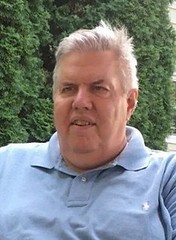 As World War I dragged on, a shortage of small change developed throughout
Germany. Municipalities, states, and private firms attempted to fill the need for
coins by producing
As World War I dragged on, a shortage of small change developed throughout
Germany. Municipalities, states, and private firms attempted to fill the need for
coins by producing emergency money
from materials such as paper, metal,
porcelain, and some even more exotic. This presentation will focus on coins
struck in metal and other materials. Coins issued after the war for collectors and
during the hyperinflation period will also be reviewed. Jim VanderRoest has been
a coin collector since the age of nine. He is an attorney in private practice in
Kalamazoo, a member of the Kalamazoo Numismatic Club and a board member
for MSNS. He is also a member of ANA.
How to Start a Local Coin Club!
Presented by Chuck Sharpe
 Interested in starting a local coin club in your village, town or city? Come listen to
Chuck discuss this topic. Former MSNS board member, and creator/restarter of 4
clubs, Chuck has a way of helping you to create a new club or improve an existing
one!
Interested in starting a local coin club in your village, town or city? Come listen to
Chuck discuss this topic. Former MSNS board member, and creator/restarter of 4
clubs, Chuck has a way of helping you to create a new club or improve an existing
one!
Technology in Numismatics
Presented by: Kevin Markman
 Host of YouTube's "Coins Making Cents", Kevin Markman has been collecting coins
for over thirty-five years. From coin collector to numismatist and now coin dealer,
Kevin enjoys sharing his knowledge of coins to all who will listen. When not working
with coins, Kevin is a computer programmer and data scientist for a local health
system.
Join Kevin as he delves into his two passions, coins and computers. He will be
discussing the tools and technology that are available to help anyone with
enhancing their appreciation of numismatics.
Host of YouTube's "Coins Making Cents", Kevin Markman has been collecting coins
for over thirty-five years. From coin collector to numismatist and now coin dealer,
Kevin enjoys sharing his knowledge of coins to all who will listen. When not working
with coins, Kevin is a computer programmer and data scientist for a local health
system.
Join Kevin as he delves into his two passions, coins and computers. He will be
discussing the tools and technology that are available to help anyone with
enhancing their appreciation of numismatics.
Acceptable Numismatics and Cultural Sensitivity
Presented by Tom Coulson
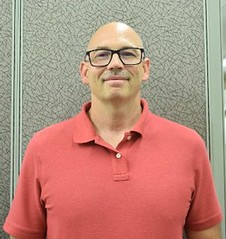 Join Tom Coulson, owner of Liberty Coin Service in Lansing, and a member of
the MSNS Board of Governors, as he discusses how Native Americans have
been portrayed on US coins and their cultural relevance to Native American
people.
Join Tom Coulson, owner of Liberty Coin Service in Lansing, and a member of
the MSNS Board of Governors, as he discusses how Native Americans have
been portrayed on US coins and their cultural relevance to Native American
people.
KUWAIT'S POLICING OF COUNTERFEIT GOLD
Vic Mason of Mamaroneck, NY submitted these thoughts on counterfeiting gold. Thanks! -Editor
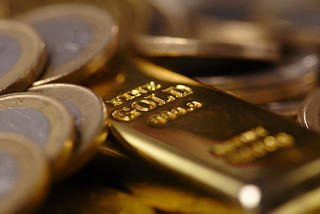 I was surprised to read that platinum was once regarded as
I was surprised to read that platinum was once regarded as a cheap heavy metal
used to produce counterfeit gold coins. Today, of course, as you write, platinum is regarded as an expensive precious metal, although no longer as pricy as gold on the global spot market based in London.
While living in Kuwait before Saddam Hussein's invasion in August 1990, I and other foreigners enjoyed visiting the local gold souk to buy coins, jewelry and other items beautifully displayed in the shop windows. Those of us interested in gold coins and bars were early on made aware by veterans to watch out for coins and bars that looked right but might really be gold-plated counterfeits.
The cheap heavy metal
of choice, we learned, was usually wolfram (tungsten), which apparently is very similar to gold in its properties. The wolfram fakes would then be plated with gold to snooker the unwary.
The Kuwait government dealt with the risk of counterfeit products by setting up an office in the middle of the gold market, where any customers, local or foreign, could take their purchases, along with their sales receipts, and a government official expert in detecting frauds and fluent in English could test the purchases. For example, whenever I bought gold Mexican, Turkish or other coins, I would immediately go to that office with my receipts.
The little office's floor was made of concrete, and the officials didn't examine how much you paid; that was to be bargained between buyer and seller. The official would simply drop the coin on the floor. If the ring
of the dropped coin on concrete didn't sound right,
the seller was in trouble, his shop would be closed down and he would be tossed into jail until he had a chance to explain himself.
An American friend told us how she had once gone there and bought what she thought was a gold bar weighing one kilogram (one thousand grams) in the gold souk but which was really plated wolfram. Fortunately for her, the government official detected the fraud and she was reimbursed. It was a valuable cautionary tale for the rest of us, never to be forgotten.
But the local English language papers in Kuwait rarely reported such stories. The merchants in the gold souk, both Kuwaiti and foreign, were usually trustworthy, and too smart to let their reputations be ruined in such a greedy manner. Kuwait was proud of its gold market, considered in those days the second best place, for price, to buy gold in the Arabian gulf region after Dubai.
To read the earlier E-Sylum article, see:
LOOSE CHANGE: NOVEMBER 5, 2023 : Gold Coins Filled With Platinum
(https://www.coinbooks.org/v26/esylum_v26n45a32.html)
TAXAY CERTIFICATES OF AUTHENTICITY
A website visitor is handling his late father's coin collection, many of which were obtained from Don Taxay. At my request he provided images of some of the coins and their accompanying documentation as a window into coin sales and authentication in the 1970s. In today's environment, the documentation is doubly important to save alongside the coins as proof of their provenance. These look like some nice coins and I'd like to help him find a current valuation. -Editor
To read earlier E-Sylum articles, see:
BREEN AND TAXAY AUTHENTICATION CERTIFICATES
(https://www.coinbooks.org/v21/esylum_v21n27a12.html)
MORE BREEN AND TAXAY AUTHENTICATION CERTIFICATES
(https://www.coinbooks.org/v21/esylum_v21n28a12.html)
XXXVII FIDEM 2023, FLORENCE, ITALY
George S. Cuhaj submitted this great report about the recent congress of the Fédération Internationale de la Médaille d'Art (FIDEM), the International Art Medal Federation. Thank you! -Editor
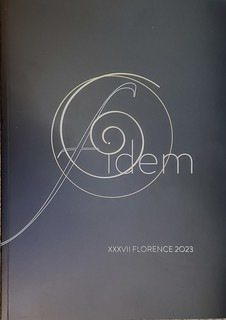 The 37th FIDEM Congress and Exhibition of Modern Medallic Art was held October 10-14th in Florence, Italy. The congress meetings, lectures, and closing dinner was held at the
Grand Hotel Baglioni, and the exhibition of some 600+ contemporary medals were on display at the Biblioteca Nazionale The public exhibition continued until November 9th. Valeria Vettorato, the Italian delegate organized the exhibition and catalog.
The 37th FIDEM Congress and Exhibition of Modern Medallic Art was held October 10-14th in Florence, Italy. The congress meetings, lectures, and closing dinner was held at the
Grand Hotel Baglioni, and the exhibition of some 600+ contemporary medals were on display at the Biblioteca Nazionale The public exhibition continued until November 9th. Valeria Vettorato, the Italian delegate organized the exhibition and catalog.
The congress format included thirty-five lectures divided into morning and afternoon sessions, some running concurrently in different rooms. All will be published in the proceedings Medallies. The opening session was chaired by FIDEM president Philip Attwood. A special after hours tour of the Bargello Museum was available to view their collection of numerous Michelangelo and Donatello sculptures.
In addition congress attendees has an opportunity to visit the minting facility of Picchiani & Bartacchi (who in recent years purchased both the Colombo and Stefano Johnson private mints (deciding to continue operating them under their individual names).
At the end of the congress, travelers to Rome were welcome for a half day tour of both the Italian State Mint as well as the Scuola dell'Arte della Medaglia.
The congress medal was designed by Gabriele Carboni, a third-year student at the medal school and struck in bronze at the Italian State Mint.
The exhibition catalog illustrated one medal in color by each participating artist, 207
numbered pages with additional advertisements. As in the past it is organized by country.
Catalogs are available for sale in the FDEM web shop under 'Others'
https://www.fidem-medals.org/shop
.
For FIDEM members, the price has been set to 40€
https://www.fidem-medals.org/shop?showmoreinfo=12142
.
For non-members the price has been set to 50€
https://www.fidem-medals.org/shop?showmoreinfo=12143
.
They will be sent postpaid.
During the congress it was approved that at the end of the year Jeanne Stevens-Sollman and Jim Licaretz current US delegate and vice-delegate will be succeded by George Cuhaj as delegate with a vice delegate to be determined.
US attendees: First row (seated) Mashiko, Jeanne Stevens-Sollman, Lindley Briggs, Anne-Lise Deering; Second Row (standing) George Cuhaj, Ira Rezak, Keiko Kubota-Miura, Alan Stahl, Roxana Nistor, Yewon Song, Heidi Wastweet, Eugene Daub; Back row (standing). Jim Licaretz, Jeffrey Briggs, Mark Benvenuto, James MaloneBeach. (camera shy: Amanullah Haidersaid). Photo by Toshi.
The next FIDEM congress will be held in Munich, Germany during October 2025. FIDEM USA membership information can be had by contacting George Cuhaj at: George.cuhaj@yahoo.com
VOCABULARY TERM: ORIENTATION
Here's another entry from Dick Johnson's Encyclopedia of Coin and Medal Terminology. I added an image of the Huntington medal as an example. -Editor
Orientation. Adjusting or rotating a numismatic or medallic design so the horizontal and vertical planes are appropriate to the viewer. This is required at several times; when the artist designs the piece, of course, when the pressman prepares his setup for striking – DIE ALIGNMENT – and when an illustration is prepared for publication. This is mostly a problem for illustrations of round coins and medals so they won't look tilted.
How to orientate round coin and medal illustrations. When coins or medals are designed, artists use obvious and subtle hints to give the viewer a perception to which way is up ... or down ... on a round design. Obvious hints are horizon lines, water lines, bases and sides of buildings and such. In numismatics we have a very often used element – the base line – which separates the design from the exergue. If a base line is present it is easy to orientate a numismatic illustration.
Most important hint of all: inscription lettering is always on a horizontal base line. Other subtle hints include: the legend – the lettering around the circular edge – usually starts and stops at the same level.
For items designed with linear perspective there are numerous clues for orientating a coin or medal: two eyes of a portrait are usually on the same level plane. The shoulder line is usually level. A profile is usually vertical.
Also look for vertical lines: sides of buildings, coats of arms, logos, trees, columns, candlesticks. Everything that should look vertical in nature – should look vertical on a coin or medal design.
In the days when all illustrations were mounted on wooden printing blocks this chore was done by the photo engraver (who mounted the zinc cut). Today it is done by the makeup artist or the layout artist. There is no excuse today to have tilted illustrations because of the ease in which they can be aligned.
See also OBVERSE and REVERSE.
To read the complete entry on the Newman Numismatic Portal, see:
Orientation
(https://nnp.wustl.edu/library/dictionarydetail/516430)
STILL MORE ON ARD BROWNING
E-Sylum Feature Writer and American Numismatic Biographies author Pete Smith submitted this follow-up with additional biographical details about Ard Browning, author of the classic reference, Early Quarter Dollars of the United States. Thank you. -Editor
Julia Casey responded to my previous article with some comments on the mother's side of the family and city directory listings. These provide a little more insight into Browning's early life.
Ard's parents were William Harrison Bolinbaugh (1839-1906) and Mary Virgil (1844-1897). Mary's parents were Baptist minister Almon Virgil (1799-1890) and Almira Stone (1815-1866). In addition to Mary, they had three children, Charles S. Virgil (1835- ), Dr. Thomas S. Virgil (1836-1899) and Almon Kincaid Virgil (1842-1921). Charles is untraced after 1850. Thomas was a prominent Indiana physician. Almon was a music teacher. It is Almon with the greatest connection to Ard Browning.
The 1870 city directory for Fort Wayne shows William Bolinbaugh living with his father-in-law Reverend Almon Virgil. William had a young family with a wife, a one-year-old son, and another son coming the following year. The elder Almon's wife had died four years earlier.
Everyone on the list is identified with a profession except William. Everyone has an address except Almon.
The 1883 Fort Wayne directory now shows William working as a sawyer. In the 1900 Census, A. W. Browning, age 30, was listed living in Manhattan as a boarder in the household of A. K. Virgil, age 60.
Almon Kincaid Virgil attended New York Central College in McGrawsville, New York, founded by
Baptists in 1849. He later studied music in Europe. He held patent 13,262 on the practice clavier
for
teaching keyboard skills. In 1870 he was Principal of the Music Department at Fort Wayne College.
Almon was the father of Charles Stone Virgil (1867-1918). His mother is listed as Jennie Rich, but she is otherwise untraced.
Almon married Mary Hannah Mendenhall (1842-1938) on August 3, 1868, in Wayne County, Indiana. She was a music teacher. In the 1870 Census, Almon, Mary and Charles were living in Fort Wayne with a domestic servant. They were divorced on March 26, 1878.
Almon, age 39, was married in Des Moines on July 23, 1878, to a music teacher, Antha Minerva
Minnie
Patchen (1852-1939), age 26, They opened a music school together. They were divorced on
May 8, 1902. Almon claimed his wife deserted him in 1896 to join a younger man and another music
teacher and spiritualist in New York City. At the divorce hearing, A. W. Browning corroborated Virgil's
statements.
In 1889 he published The Virgil Clavier Method: Foundation Exercises. He and Florence founded the Virgil Practice Clavier company in 1890 and The Virgil Piano school in 1891.
Almon Kincaid Virgil married Florence Dodd (1869-1944) on March 25, 1903, in Manhattan. She was younger than his son.
In 1913, Almon and Florence applied for a passport to travel for a year in England and Germany. It was issued without any problem. They were forced to leave Berlin in 1914 as hostilities broke out leading to the First World War. They attempted to return in 1919 but were denied a passport for travel that was not considered essential.
Almon died on October 16, 1921, and is buried at Greenwood Cemetery in Saint Petersburg, Florida, with his wife Florence.
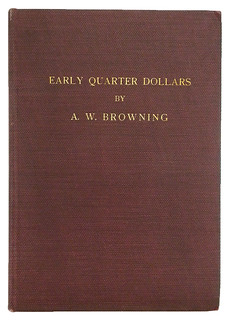 Almon Kincaid Virgil was well known and respected from a family of professionals. Ard Browning came
from a family of modest means and lived without attracting much attention. He achieved fame only from
writing one book.
Almon Kincaid Virgil was well known and respected from a family of professionals. Ard Browning came
from a family of modest means and lived without attracting much attention. He achieved fame only from
writing one book.
This is a listing of the places of residence for Ard Browning:
- January 12, 1869 Born in Chicago.
- 1870 Living with parents and grandfather, Almon Virgil in Fort Wayne, Indiana
- 1880 Living with parents and brother in Pierceton, Indiana.
- 1900 Boarder at 26 15 th Street in Manhattan, living with Uncle Almon Kincaid Virgil as foreman.
- 1905 Lodger in Manhattan.
- 1910 Lodger at 21 16 th Street in Manhattan, as clerk in a plumbing firm.
- 1915 In New York City.
- 1920 Employee at Central Islip State Hospital as stenographer.
- 1930 At Central Islip State Hospital as stenographer.
- May 24, 1933 Died in Chicago and buried at Schwenkfelder Church in Palm, Pennsylvania.
In the past twenty-five years, researchers have found various government records for Browning. No one has come up with stories about him or memories of meeting him.
To read the earlier E-Sylum article, see:
ARD BROWNING DISCOVERY
(https://www.coinbooks.org/v26/esylum_v26n44a13.html)
DAVID SCHENKMAN INTERVIEW, PART TWO
Greg Bennick's latest interview for the Newman Numismatic Portal is with token expert David Schenkman. Here's the second of six parts, where Dave discusses discovering Civil War Tokens. -Editor
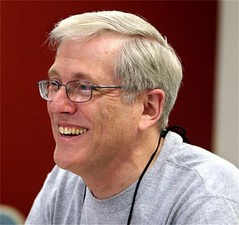 Now, getting to the tokens. Around 1961 I guess, I started working part time for a man in
Norfolk, Virginia, where I lived, who had a coin shop. He was a retired Navy officer and I
would do whatever he wanted me to do with coins. And one day he gave me a box of Indian
head cents and said he wanted me to attribute them and pack them up for sale. So, as I was
going through them, there was a half dozen of these coins that were not Indian head cents, they
were different. They had advertisements on them and some of them resembled Indian head
cents. And so, I asked him what they were and he said they were Civil War tokens.
Now, getting to the tokens. Around 1961 I guess, I started working part time for a man in
Norfolk, Virginia, where I lived, who had a coin shop. He was a retired Navy officer and I
would do whatever he wanted me to do with coins. And one day he gave me a box of Indian
head cents and said he wanted me to attribute them and pack them up for sale. So, as I was
going through them, there was a half dozen of these coins that were not Indian head cents, they
were different. They had advertisements on them and some of them resembled Indian head
cents. And so, I asked him what they were and he said they were Civil War tokens.
I was fascinated by them because there was so much more diversity than there was with the cents which were the same except for the dates. He gave them to me, and I started collecting Civil War tokens. And I was a member of a couple of local coin clubs. And I would pester everybody for tokens and people would bring in tokens because very few people were interested in them, at least where I lived. And I got to the point where I had probably about two hundred Civil War tokens, and what I started seeing were duplicates of everything that I had. When I'd see something else, like I wasn't picking up anything new, so I sort of assumed that I probably had them all. And then somebody gave me a copy of George Fuld's book on Civil War tokens, actually two little black books. And my bubble burst because he listed about 7000 varieties. So, I realized I didn't know a whole lot about these, but I had a book! So now I could at least find out which ones were rare and which ones were common. And so that really spurred my interest. And from there I branched out to other types of tokens and obsolete paper money and to a certain extent, coins also. And eventually I went in the coin business full time. I did that for a number of years. I'm no longer doing that, but I still have as much interest in coins as I always did.
Greg Bennick: Well, let's take one step back. Let's say for a beginning listener, what is, since you mentioned them first, a Civil War token?
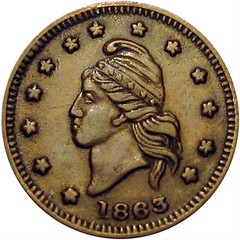 David Schenkman: Civil War tokens, as you might assume, were issued by merchants during
the Civil War. And the reason they were issued was because there was a shortage of currency.
People started hoarding gold shortly after the Civil War broke out. Then they started hoarding
silver and eventually it got to where they were hoarding copper. So, these civil war tokens,
which were generally the size of a cent in a lot of cases, resembled an Indian head cent. They
filled the gap. They could circulate and they served two purposes because not only did they
advertise a merchant, but the merchant could buy them in quantity for less than a penny apiece
as the going price for a thousand of them was about $8 to have them made. So, you could
actually make a profit issuing these coins.
David Schenkman: Civil War tokens, as you might assume, were issued by merchants during
the Civil War. And the reason they were issued was because there was a shortage of currency.
People started hoarding gold shortly after the Civil War broke out. Then they started hoarding
silver and eventually it got to where they were hoarding copper. So, these civil war tokens,
which were generally the size of a cent in a lot of cases, resembled an Indian head cent. They
filled the gap. They could circulate and they served two purposes because not only did they
advertise a merchant, but the merchant could buy them in quantity for less than a penny apiece
as the going price for a thousand of them was about $8 to have them made. So, you could
actually make a profit issuing these coins.
Greg Bennick: So, it sounds in a way much like Conder tokens and the role that they served in in the UK, where there just was a shortage of coinage and these coins were made to supplement a lack of coinage, to provide for commerce to continue to exist. I guess that was the same thing with Civil War tokens then.
David Schenkman: Well, it was. And like Conder tokens, a lot of them were made for
collectors. There were collectors of these tokens during the war and shortly after the war. The
collectors that lived in the areas where there were die sinkers that were making Civil War
tokens would go to the die sinker to look at his dies and say well, make the five of these with
this die and this die, make me five in silver and fifteen in German silver or whatever. And they
were creating - instant rarities - that now sell for large amounts of money. And what they would
do is they would put one in their collection and then they would trade with collectors in other
areas that were doing the same thing with die sinkers in their areas. And so, a good deal of the
Civil War tokens are really not legitimate
in the sense that they were never intended for use.
And some of them were actually struck after the war.
Greg Bennick: So, they were struck almost as numismatic delicacies the way that in the 1870s or so, there was a number of numismatic delicacies in terms of patterns made at the Mint for collectors at their request and whatnot. These were things that were made both by the die sinkers themselves, but maybe at the request of collectors also in order to create delicacies or rarities.
David Schenkman: Well, everybody likes a rarity. They were doing the same thing with Conder tokens in the 1790's because there were coin… in fact some of the Conder tokens advertised coin dealers.
Greg Bennick: So basically, the coin dealers who were using the opportunity that Conder tokens, for example, were making rarities and striking those rarities as advertisements for the fact that they were selling those rarities! It's pretty convenient.
David Schenkman: Yeah.
Greg Bennick: So taking a step even further back. Of course, tokens and Civil War tokens and Conder tokens all fall under the token banner. Tell us about tokens. There are so many. And I know that my father was a token collector and you've specialized in tokens. You've made mention of the merchant connection to tokens. Tell us what a token is. And I don't mean that as such a rudimentary question as to say a disk of metal, but when people think of tokens, they think maybe of just transportation tokens first and foremost. But tell us about what a token is and the purpose that they served in terms of commerce over the last few hundred years.
David Schenkman: Tokens serve a lot of purposes over the years. As you mentioned, transportation merchants issued tokens extensively from the 19th century and the 20th century up until even modern times, although to a lesser extent. And these tokens were generally, one side would say the name of the merchant might say Joe Blow's Saloon, Bluefield, West Virginia, and the other side would say good for $0.05 in trade or good for a drink or something of the sort. And they were circulated in various ways, and they weren't really intended to circulate the way Civil War tokens circulated. In some cases, the bartender would charge $0.25 for two drinks. So, when you paid a quarter for two drinks, he would give you one drink and a token that was good for a drink. This way he ensured future business. So that was another use for them. Some tokens were just strictly advertising. These are generally larger. We could spend the next hour talking about the uses of tokens because there's lots of uses.
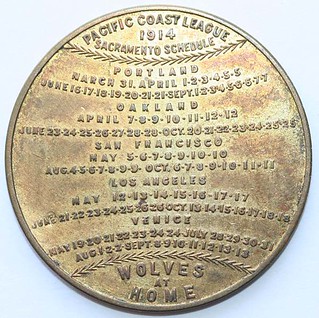 I've compiled for
many years a catalog that may never get printed, but I still compiled it of sports schedule
tokens, and these tokens are generally the size of a silver dollar roughly. And one side
advertises a merchant, the other side will have that year's schedule for the local football or
baseball team. So, the merchants would give these to customers who would be apt to keep them,
at least during the season that they showed the schedule of, and they served as a reminder of
that merchant's business.
I've compiled for
many years a catalog that may never get printed, but I still compiled it of sports schedule
tokens, and these tokens are generally the size of a silver dollar roughly. And one side
advertises a merchant, the other side will have that year's schedule for the local football or
baseball team. So, the merchants would give these to customers who would be apt to keep them,
at least during the season that they showed the schedule of, and they served as a reminder of
that merchant's business.
Greg Bennick: So basically, mechanisms of not just advertising but of keeping business going. It seems quite obvious to say, but your allusion to the fact that there's a countless number of ways that tokens were used is fascinating because it makes me think, how does one collect them? Meaning it's very easy if putting together a date set, which is sort of a modern approach to coin collecting and collecting by date certainly wasn't always a thing. And I guess my question is, how does one then collect tokens? It's very easy to collect if you're looking for a date set of Indian cents, but what do you do in terms of tokens? How do people approach collecting these things?
David Schenkman: Well, that's not an easy question to answer, but in general terms, I think most importantly, well, two things. One, buy books. It's not as simple as collecting coins where a Red Book might get you by. You need books, and there's a lot of them. And they tend to be pricey because they're usually published in small quantities. But if you know what you're doing, they can make you a lot of money if you're buying for investment or for resale. And the other thing is to join numismatic organizations, for instance with tokens, the Token and Medal Society, which is a national nonprofit organization that's been in existence since 1961. I believe you're a recent member.
Greg Bennick: Yeah, I am.
David Schenkman: And they publish a magazine six times a year and occasionally supplement issues on specific topics, and they also publish books from time to time. There are other organizations that are more specialized. For instance, there's a transportation token society that publishes a monthly newsletter, and they've been doing that since, I believe, 1948. And of course, the American Numismatic Association, I would be remiss if I didn't put in a plug for them because that's our national magazine. And they have articles on tokens and medals and paper money and whatever else you might imagine.
Greg Bennick: While we're on the subject, I'll say that the Token and Medal Society puts out a magazine, as you said, the TAMS Journal, and this has a full color cover, it's on glossy paper, it's pretty nice and full color all throughout. It's a really impressive magazine. I actually just got my first issue the other day flipping through, seeing your article, and then there's just a wide variety of articles. And what's interesting is that I don't have an extensive background with tokens, and still I joined just to learn something brand new about an area of numismatics that I know very little about. And there's a lot of that to learn in this magazine. So I'd highly recommend that without a doubt. And I agree with you also about books.
One thing I want to ask you about for sure is a really specific topic. I just bought a copy recently of your book, Virginia Tokens, that's about as specific as you're going to get. I mean, this book, I'm looking at here it's about an inch and a half thick. It's got about 600 pages, and you could probably tell us more about it. But this is a really specific work, and I can't imagine a greater reference on Virginia tokens. It's enough, just this book alone to get one started, a collection of these things. What could you tell us about that book specifically?
David Schenkman: Well, in the first place, it's absolutely the best reference on Virginia tokens ever written, primarily because it's the only reference! So getting back to the tokens with this is a good example as any. I wrote the first version of this book in 1980, and it was about 200 pages in it, and it listed 2500 tokens. That was every token that I knew about from the State of Virginia. And I had corresponded extensively with other collectors and looked at collections and went up to the ANS in New York. But this book that you just got, which was published by the Virginia Numismatic Association four or five years ago, I guess, lists 6000 tokens - well over twice as many. So that's as many tokens that have come out, not come out, that's a bad choice of words, but have been discovered since the first edition.
One thing that people should remember about tokens is the fact that it's not as easy to
understand as it is coins. For instance, if you collect Lincoln cents you know exactly where you
stand in the hobby, you need seven dates to complete, you need this, you need that. With
tokens, there's really no way of knowing when you're complete because you probably never are.
So that can be a frustration or it can be a satisfying thing because you can also find things that
nobody else has ever found. The problem is if you want to collect is you can't just go out and
buy everything you want to buy. And a good example as any, I collect seriously a Virginia
transportation tokens. I've got almost every one known to exist except for one company that
operated out of Suffolk,Virginia and it was a bus company that operated during the thirties, I
believe. They issued four tokens. They're very distinctive types of tokens. I bought two of them
in probably the 1980s, sometime around there. And since then, I've looked for the other two.
Last year, one of them came up at an auction, I was able to buy it for $400, roughly. I would
have paid more. I would love to buy the last one, and I would pay more than $400 for it, but you
can't just go out and buy it. In tokens, we tend to call something not rare if there are maybe 20
of them around, we don't term it rare
anymore because there's that many of them. Putting it
another way, the Virginia token book that you bought, the 6000 tokens that are listed, I would
imagine that every token listed in that book is quite a bit rarer in terms of numbers made than a
1909 S VDB penny, and yet they're not nearly as valuable.
Greg Bennick: Is this because less were made. Or is this because less of them survived after many many were made, that there's so few around today?
David Schenkman: I acquired years ago the mintage of photocopy of an original die sinker who manufactured coal mine scrip tokens from the twenties through the fifties. And some of the mintages are as high as a thousand, a lot of them are under a hundred. I've owned plenty of tokens with a total mintage with only fifty, so obviously if only fifty were made, there's not going to be a lot of them around.
Greg Bennick: Now, it's interesting that you brought up the fact that tokens are an area of
numismatics that you might pursue and never finish. When I interviewed Bill Groom recently
and Bill's specialty is counterstamps, Bill referred to counterstamps as the last great frontier of
numismatics
. And what he was referring to was the fact that there are always going to be
counterstamps that can't be identified, that might be identified, that are being identified or that
were recently identified and connected with specific merchants. And it almost seems that tokens
are a similar thing and as you said, one might find a new discovery of a token that has never
been discovered before. Do you feel the same about numismatics and the frontier that Bill
Groom described in terms of tokens and where they fit into the whole numismatic world?
David Schenkman: I think that there are a lot of frontiers in numismatics, and I've never been
able to understand the obsession that some collectors have, and I hope I'm not going to alienate
too many people when I say this, with getting a coin that a grading service is graded at one
point higher than the one below it and paying three times as much for that one point when you
generally can't even see it unless you really know what you're looking for. So as far as frontiers
go, Bill is correct, there are a lot of counterstamps that will never be identified. There are also
lots of tokens that will never be identified. The are what we refer to as mavericks and a
maverick is a token that does not contain enough information in its inscription to enable
identification. And interestingly enough, the term maverick comes from a rancher in Texas in
the 19th century who refused to brand his cattle, and his name was Sam Maverick. And
unbranded cattle came to be referred to as mavericks
. And that term is now used by token
collectors. It's a fairly standard term to describe a token that's unidentified.
Greg Bennick: I've never heard that before. That's totally fascinating.
David Schenkman: If you look at the one section of the TAMS Journal, every issue there is a maverick section, usually four or five pages towards the back and those are all mavericks. There's a section of ones that people have identified, and there is a section of ones that have not been identified that people have sent in descriptions of.
Greg Bennick: Wow, I'm literally looking at it right now. So, these are things that people are finding, figuring out, and connecting to historical sources and references. It's literally the frontier that we're talking about. Meaning that it's people doing the research about this field of numismatics as we speak. You know, basically in time for the next issue of the TAMS Journal to come out. It's pretty fascinating that people can be that participatory because you're right, it's quite true that I don't know if people are going to discover anything new about the Morgan dollar series with the same speed perhaps, or the same amount of discoveries as seems to be happening in tokens and counterstamps.
David Schenkman: Yeah. And they've been running that column pretty much since the first days of the magazine, which was 1961. A lot of tokens have been published in that magazine over the years. I edited that magazine for 27 years, and I can tell you that there's an amazing diversity of articles.
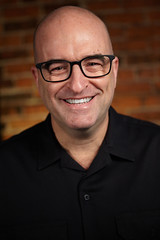 About the Interviewer
About the Interviewer
Greg Bennick (www.gregbennick.com) is a keynote speaker and long time coin collector with a focus on major mint error coins. Have ideas for other interviewees? Contact him anytime on the web or via instagram @minterrors.
To watch the complete video, see:
David Schenkman Interview
(https://nnp.wustl.edu/library/book/632911)
To read the complete transcript, see:
David Schenkman Interview (Transcript)
(https://nnp.wustl.edu/library/book/632910)
To read the earlier E-Sylum article, see:
DAVID SCHENKMAN INTERVIEW, PART ONE
(https://www.coinbooks.org/v26/esylum_v26n45a12.html)
EXHIBIT REVIEW: REALLY BIG MONEY
Tom Babinszki publishes the Blind Coin Collector blog, and his latest article discusses his recent visit to the Smithsonian's new exhibit, Really BIG Money. Great review! Thanks for helping the rest of us understand the perspective of a blind visitor. -Editor
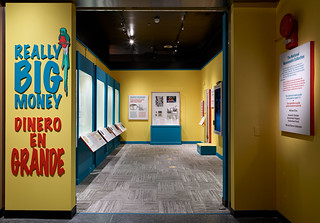 Recently I learned that the Smithsonian has a new accessible exhibit, called Really BIG Money. And you know me, I just need to check things like that, so I used the excuse that flying home from Cincinnati there was no direct flight and I had to switch flights in Washington DC. Layovers are where good things happen.
Recently I learned that the Smithsonian has a new accessible exhibit, called Really BIG Money. And you know me, I just need to check things like that, so I used the excuse that flying home from Cincinnati there was no direct flight and I had to switch flights in Washington DC. Layovers are where good things happen.
I contacted Jennifer Gloede, who put me in touch with Ellen Feingold, who set up a meeting with me, and was very kind to work with my schedule so I could visit the exhibit on my way home.
When we met at the Smithsonian, Julia Garcia and Shira Goldstein also joined us, who were also instrumental in putting the exhibit together.
The target age group of the program is third to fifth grade children. From the beginning I felt that they very professionally met the needs of this age group. Objects, pictures and any interaction were placed lower, text was short and easy to read, and in general the entire place felt a little breezy, just not too overwhelming. As I always say, what's necessary for some people, can benefit others. In this case, such an approach definitely makes interaction easier for children with cognitive disabilities, while creating a more digestible experience for all kids.
What was dense, though not overwhelming, is the information they managed to communicate with so few objects. Instead of showing a lot, they managed to create selection in a way that any individual object communicates many things at the same time allowing greater learning and conversation.
- On one side, there are four monetary objects:
- A 20 Quetzales from Guatemala
- A Swedish plate money
- A picture of a head made of 165 Roman coins
- A stone that is used to make Yap money.
Each object can be touched, and there is information about it that students can read.
But here is the genius approach to how they squeezed so much information into it.
Let's take the Quetzal for example. It is not just a coin, there is so much to talk about in connection to it. For example on the enlarged tactile coin one can easily feel the feather of the Quetzal bird. One can discuss what and why countries put on coins, how the money of Guatemala was named after a bird, how the feathers of the quetzal was used for trading, etc. Also notice that each object is from a different continent.
What I also liked about the exhibit is its global approach. While most likely the majority of the students visiting will be from the United States, they an learn about the entire world, and put into perspective what they can learn. For example when they display inflated banknotes, even the number of zeros would wow a student at this age, but they go further and explain that in 1923 a wheelbarrow of money could buy a loaf of bread. And then before you think that ok, it's just history, next they go to Venezuela and show that the same thing can happen right now, in our lifetime. I jokingly mentioned that I miss the example from Hungary where they had the highest ever inflation in 1946. But for all practical purposes, I think it made more sense to compare Germany and Venezuela to cover a larger time span and give more tangible examples.
After learning about inflation and tool money, students can put to the test what they learned in a game. And here comes the big surprise. One can plugin a headset, and play the game using a screen reader.
Because what should education be? Fun and play. And while students can participate in the learning, as a blind child I would probably feel neglected if I couldn't participate in the play part. But here it is not the case. And at the very end, children can take a picture of themselves and place it on a Dollar bill. I have seen this idea in many museums, and I have to say, it is a big deal for kids. Even for me, I stood in line for some of those.
It is unbelievable how much education and play the team managed to squeeze into a 250 square foot room without being overwhelming.
I remember when I was in about fourth grade, I hated museums with a passion. For me there was nothing to do, nothing to touch, and I felt I was wasting my time while the rest of the kids were having fun. It wasn't only boring, but it was humiliating in so many ways. It is really a dream come true for me that it doesn't have to be the case, and kids with disabilities will be able to approach museums with a different mindset and love them just like anybody else.
If you are a teacher, I would highly recommend that you take your class to see this exhibit. If you are building exhibits, it is also a must see to learn from.
For those of you who are not able to travel to DC, similar accessible content, including the game is available online.
I would like to thank Ellen and the entire staff for allow me to view this exhibit, but most importantly for putting so much thought into accessibility.
To read the complete article, see:
Really BIG Money at the Smithsonian
(https://blindcoincollector.com/2023/11/08/really-big-money-at-the-smithsonian/)
To read the earlier E-Sylum articles, see:
NEW SMITHSONIAN GALLERY: REALLY BIG MONEY
(https://www.coinbooks.org/v25/esylum_v25n15a11.html)
MAKING THE REALLY BIG MONEY EXHIBIT
(https://www.coinbooks.org/v25/esylum_v25n24a15.html)
ANA MONEY MUSEUM RECEIVES AWARD
Congratulations to the ANA for their recent Museum Technology award. Here's the press release. -Editor
Prestigious Technology Award
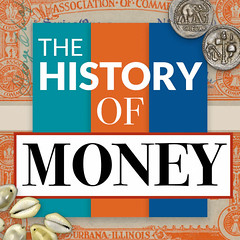 The American Numismatic Association's (ANA) Edward C. Rochette Money Museum, located in Colorado Springs, Colorado, was the recipient of the Mountain Plains Museum Association's (MPMA) 2023 Award for Museum Technology. The MPMA Technology Competition recognizes museums for innovative and effective use of technology to serve the needs of their audience. This is a juried competition with a minimum of three judges selected from among museum and media professionals with expertise in media and technology programming, production and content development.
The American Numismatic Association's (ANA) Edward C. Rochette Money Museum, located in Colorado Springs, Colorado, was the recipient of the Mountain Plains Museum Association's (MPMA) 2023 Award for Museum Technology. The MPMA Technology Competition recognizes museums for innovative and effective use of technology to serve the needs of their audience. This is a juried competition with a minimum of three judges selected from among museum and media professionals with expertise in media and technology programming, production and content development.
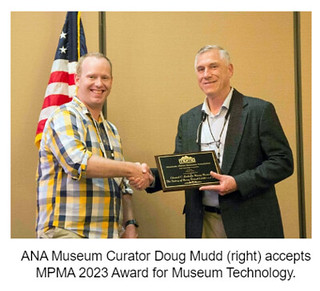 The Money Museum was selected to receive the award for the History of Money exhibit 360 Virtual Tour created by the team of ANA Museum Curator Douglas Mudd, ANA Creative Services Manager Ben Scott, ANA Photography Director Rob Kelley, and ANA Digital Content Director Pete Gentzler. The award was presented on September 29 at the MPMA's annual conference, held this year in Corpus Christi.
The Money Museum was selected to receive the award for the History of Money exhibit 360 Virtual Tour created by the team of ANA Museum Curator Douglas Mudd, ANA Creative Services Manager Ben Scott, ANA Photography Director Rob Kelley, and ANA Digital Content Director Pete Gentzler. The award was presented on September 29 at the MPMA's annual conference, held this year in Corpus Christi.
The History of Money exhibit 360 Virtual Tour displays how money has evolved over the last 10,000 years – from the earliest forms of money to present day. Anyone with access to the internet can access this exhibit by visiting money.org/hom-vrtour/.
The Money Museum is operated by the nonprofit American Numismatic Association, which is dedicated to encouraging the study and collection of coins and related items. The ANA helps its members and the public discover and explore the world of money through its vast array of educational programs including its museum, library, publications, conventions and webinars. For more information, call (719) 632-2646 or visit money.org.
WBNA WORLD CURRENCY SALE 51
Consignment Director Ryan Baum of World Banknote Auctions sent along these highlights and comments on their upcoming World Currency Sale 51. Thanks. -Editor
We have had so much demand for European paper that we divided our current auction European Session to close a day ahead of the remaining notes.
Within the European session I am partial to a 50,000 Lire note in amazing Gem 68 EPQ condition. Although note the highest denomination of the series, its image of Leonardo DeVinci has made this an iconic note.
Italy 4.2.1974 P-99c PMG Superb Gem UNC 68 EPQ 50,000 Lire
A popular type from Italy with Leonardo DaVinci's image, which at the time of issue was the second highest denomination in circulation. It is scarce in higher grades, as putting one of these away required considerable investment at the time. This is an eye popping note in pristine condition that would serve as the perfect type representative for this issue.
To read the complete lot description, see:
Italy 4.2.1974 P-99c PMG Superb Gem UNC 68 EPQ 50,000 Lire
(https://bid.worldbanknoteauctions.com/lots/view/4-BO6J8W/italy-421974-p-99c-pmg-superb-gem-unc-68-epq-50-000-lire)
Another interesting note is a Bank of Ireland 1 Pound from the Ploughman series issued after the island's division. This note shows only the slightest use of circulation and displays it featured design well.
Ireland - Eire, Bank of Ireland 10.1.1939 P-8b PMG About UNC 55 1 Pound
From the ploughman series of Ireland, which allowed private banks such as this to continue issuing notes in Ireland after the division of the country (for a limited time). Always a popular series, this is a fresh and problem-free example just a touch below uncirculated and seldom seen in such grade. Strong color and originality can clearly be seen in the PMG holder, making this a perfect representative for the type.
To read the complete lot description, see:
Ireland - Eire, Bank of Ireland 10.1.1939 P-8b PMG About UNC 55 1 Pound
(https://bid.worldbanknoteauctions.com/lots/view/4-BO6J7F/ireland-eire-bank-of-ireland-1011939-p-8b-pmg-about-unc-55-1-pound)
I am amazed at how long the Bank of England kept its notes on plain white paper as if frozen in time from the 18th century. While the United States struggled with our updated designs at the close of the 20th century, this plain white 5 Pound note was issued after World War II when much of the rest of the world was already issuing brilliantly colored notes.
Great Britain 17.3.1947 P-343 PMG Superb Gem UNC 67 EPQ 5 Pounds
Tied for finest in the PMG population report for this Pick number, and an excellent representative of this popular and long-running type. Only a few years later this design would finally be retired.
To read the complete lot description, see:
Great Britain 17.3.1947 P-343 PMG Superb Gem UNC 67 EPQ 5 Pounds
(https://bid.worldbanknoteauctions.com/lots/view/4-BO6J68/great-britain-1731947-p-343-pmg-superb-gem-unc-67-epq-5-pounds)
Within the "Rest of the World Segment," we have a rare Puerto Rican proof issued during Spain's control of the island and whose underlying issued notes remained valid for use well into the U.S. control following the 1898 Spanish American War.
Puerto Rico ND (ca.1889) P-10p1 PMG Choice UNC 64 20 Pesos (Front Proof)
The Banco Espanol de Puerto Rico, or Spanish Bank of Puerto Rico was established by Royal decree in May of 1887, commencing operations on the island in February of 1890. The bank would be a prolific issuer of notes until the end of that decade, when the island became a United States territory. The notes remained valid for circulation until 1926, when they were finally withdrawn. This extensive circulation period no doubt contributed to the rarity of these notes in issued form, as except for the lowest denomination, issued notes from the Banco Espanol de Puerto Rico are extremely rare. Proofs and specimens, typically from the ABNC archives, are more available, but remain rare. This front Proof is particularly interesting as it has printer's annotations that display the location of secret marks added by the printer, perhaps as a way to identify counterfeits. Highly unusual and rare as such, with strong eye-appeal, and an important opportunity for the Spanish colonial or Puerto Rican specialist. PMG Mentions "Printer's Annotations".
To read the complete lot description, see:
Puerto Rico ND (ca.1889) P-10p1 PMG Choice UNC 64 20 Pesos
(https://bid.worldbanknoteauctions.com/lots/view/4-BO6OJR/puerto-rico-nd-ca1889-p-10p1-pmg-choice-unc-64-20-pesos)
We also are fortunate to have several color trial specimens on the early Qatar & Dubai issue. This short-lived series was intended to replace the Indian Rupee and Gulf Rupees in commerce when started in the 1960s.
Qatar & Dubai ND (ca. 1960s) P-4cts PMG Choice UNC 63 25 Riyals (Color Trial Specimen)
A Color Trial Specimen of Qatar and Dubai's 25 Riyals note, the key denomination of the series, and a classic Middle Eastern banknote. Following the dissolution of the Ottoman Empire, Great Britain established various Protectorates in the Persian Gulf region. These political affiliations endured for decades until 1971, when the Emirates gained independence, ultimately forming the United Arab Emirates and issuing its inaugural banknotes in 1973. However, the earliest banknotes for what would become the UAE were introduced in Dubai in 1966, as it entered into a currency pact with Qatar. At that time, the circulating banknotes included Indian Rupees and Gulf Rupees, both printed in India.
The currency amalgamation between Qatar and Dubai proved to be a triumph, with their banknotes circulating widely in both regions. This series encompassed denominations of 1 Riyal, 5 Riyals, 10 Riyals, 25 Riyals, 50 Riyals, and 100 Riyals, all produced by the British company Bradbury & Wilkinson. While all denominations featured the same design, they differed in color and increased in size with each denomination. The 25 Riyals note, vividly blue, measured approximately 140 x 70 millimeters. The front of the notes featured entirely Arabic text, including the serial numbers, while the back was in English, denoting the notes as issued by the Qatar & Dubai Currency Board.
The final note was issued with a primary blue color and estimates indicate fewer than 1,600 notes remain outstanding. This Color Trial's primary color is green and affords a rare opportunity to acquire an early specimen of one of the Middle East's rarest notes. PMG mentions "Previously mounted".
To read the complete lot description, see:
Qatar & Dubai ND (ca. 1960s) P-4cts PMG Choice UNC 63 25 Riyals (Color Trial Specimen)
(https://bid.worldbanknoteauctions.com/lots/view/4-BO6OKB/qatar-dubai-nd-ca-1960s-p-4cts-pmg-choice-unc-63-25-riyals-color-trial-specimen)
NOONAN'S NOVEMBER 2023 WORLD BANKNOTES
Here's a press release announcing Noonan's upcoming banknote sale. -Editor
An Iraq specimen note that was printed in India during the Second World War is expected to fetch at least £70,000 when it is offered at Noonans Mayfair on the first day of a two-day sale of World Banknotes on Wednesday, November 29, 2023.
Described by Andrew Pattison, Head of Banknote Department at Noonans: As most exciting banknote to come to market anywhere in the world this year,
the Iraq 100 Fils specimen was printed by the Nasik Press in India during the Second World War and given to the Director-General of Finance, Abraham Elkabir.
He continues: It is an almost mythical banknote; it has never been offered at auction before and is unlikely to ever come up again. The note issued for a matter of weeks and only a single low-grade example is believed to have survived. For dedicated collectors of Iraq, this auction represents the only chance to complete the Iraq series once and for all.
The specimen 100 Fils dating from 1941 with the serial number O/00 000000 is decorated with a portrait of King Faisal II as a baby at right carries an estimate of £50,000-£70,000 [lot 499], while a specimen 50 Fils from 1944 with the serial number A000000 and a portrait of King Fasial II as a baby is expected to fetch £30,000-£40,000 [lot 500]. They are being sold by a descendant of the original recipient, who is still named Elkabir.
The sale will also include the first major part of the Peter Holland Collection, which is a superb group of world notes from China, Hyderabad, Ceylon, and Sweden, as well South Africa. Many of these notes have not appeared in auction anywhere for well over a decade.
Included will be the highest denomination Swedish note ever produced and only a handful survive. From the Sveriges Riksbank in Sweden, the 10,000 Kronor note dates from 1939 and carries an estimate of £10,000-£14,000 [lot 907].
As Andrew Pattison explains: When this note was issued, it was worth the equivalent of four kilograms of solid gold and would easily have purchased an average house. It is believed that only a single example of this note exists in private hands in uncancelled form, so this is likely the only way a collector will be able to acquire an example of this, possibly the rarest 20th-century Swedish banknote.
Also from the Holland Collection is a unique copy of a 5 Rupee note issued in 1881 in Ceylon (Sri-Lanka) by a British Bank, the Oriental Bank Corporation and is estimated to fetch £6,000-£8,000 [lot 247].
Mr Pattison notes: This note was issued in a very small mountainous region called Haldemulle (now Haldummulla) and is in a remarkable state of preservation. Notes like this were issued in tiny quantities and for only very short periods of time, so we believe this may be the only surviving example and will probably never appear on the market again.
For more information, see:
https://www.noonans.co.uk/
DAVISSONS E-AUCTION 48
Davissons is holding their E-Auction 48 on December 6th. Here's Allan Davisson's introductory note to the catalog. -Editor
Our first print catalog published the summer of 1973 included an opening note. Since then, I think the record is pretty much unbroken—opening comments, about the catalog or related issues. In a print catalog, each bit of space represents some real estate that might be used to offer things for sale. So, clearly, communicating with you has always been a high priority for us.
Everyone here has focused for many weeks on putting this catalog together. So, for us this note is a wrap-up. For you the reader it provides an overview before you start to turn the pages or change the screen.
- Gold: We have an appealing group: choice Byzantine with an exceptional histamenon nomisma (Lot 5); some small one-ounce proofs with interesting topics, hundred-year-old (more or less) gold including three particularly high-grade slabbed pieces, and some interesting US material including a Dahlonega 1851 piece.
- Greek and Roman: Some appealing and affordable Greek pieces, including a handsome tetradrachm of Lysimachos and many old collection-toned and patinated pieces… The Roman section is particularly worth study—Republican brockage errors and Republican issues, interesting Provincial and very nice Imperial denarii, antoninianii, and folles; look closely at the issues of the Third and Fourth Centuries—a comprehensive covering of most of the reigns, all handsome coins carefully selected from one particularly discerning collector's efforts.
- Britain: Some Anglo-Saxon including an appealing piece from the reign of Offa followed by a William II penny that looks better in hand than in the photo. Scotland, Ireland and the Anglo-Gallic issues form a small part of the sale but all these are areas that have not shown up much in recent sales. Five Irish hammered coins may not sound like much but that particular series has always been the scarcest of the British issues and five decent pieces is worth mention. The Irish penny of John is fascinating in its design and the Irish silver farthing is an almost impossible piece to find in any condition. Both are estimated conservatively—neither has shown up recently enough that I was able to find any parallels.
- D&H Tokens: Our Summer 1973 catalog offered about a dozen pieces from the series and they have been an important part of our focus ever since. (Recently I watched, and did some bidding, in the Patrick Deane III sale and kept notes on the winning bidder numbers. So many went to the same number that I am sure there were many frustrated bidders in the room and online.) In our sale herein, you will find some particularly appealing Scottish and Irish tokens, most of which are scarce even if Dalton & Hamer don't say so.
- Lincoln cents: Many of us began collecting when someone gave us a Whitman penny board and we started looking through rolls of pennies to fill all the holes. It was pretty easy to fill the later boards and albums (1941 to date) until Whitman decided to include the 1955 double-die. The double-die '55 piece offered here is the first I have handled and it is choice—AU58, a grade I consider more desirable than a low number MS piece. The three 1943 zinc-coated steel pieces look amazing—surfaces unlike the hundreds of steel pieces that we usually see. (I still find Lincoln cents fascinating. It was a pleasure to get this series to have and handle even briefly.)
- The rest of the sale speaks for itself—unusual items, historic items, large lots that include many worthwhile coins. These lots offer pieces of not enough value to warrant offering as a single piece in a print sale but their historic nature and appeal remain.
Finally, this catalog represents an end to two of the most interesting and important consignments we have handled:
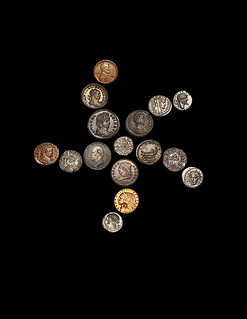 The Frank Robinson Collection of English milled coins, a collection that has helped fill our auctions for several years. The Maundy sets, lots 188 to 193, are the last items we have from this substantial and exhaustive collection of milled coins. Frank is a particularly knowledgeable collector/dealer who formed the collection over many years and we were fortunate and privileged to be able to handle it.
The Frank Robinson Collection of English milled coins, a collection that has helped fill our auctions for several years. The Maundy sets, lots 188 to 193, are the last items we have from this substantial and exhaustive collection of milled coins. Frank is a particularly knowledgeable collector/dealer who formed the collection over many years and we were fortunate and privileged to be able to handle it.
The other major consignment has been The Patrick Zabel Collection. I knew Patrick well. We often conversed and I provided many pieces to his collections. He knew many of the dealers, particularly small-firm specialists like we were, and built an outstanding Anglo-Saxon collection along with lesser—but still impressive—collections of Spanish American issues and representations of other historic areas. He built his collections with a discerning eye and on a budget, carefully acquiring choice material over many years.
We have already begun putting together our early 2024 sale, our next signature annual sale where we offer some of the best that we find. There is still room for more. We will appreciate your consignment and handle it as best we can.
For more information, or to bid, see:
Welcome to E-Auction 48
(https://davcoin.com/news-item/welcome-e-auction-48)
https://davcoin.com/sale/E-Auction%2048
NUMISMATIC NUGGETS: NOVEMBER 12, 2023
Here's a selection of interesting or unusual items I came across in the marketplace this week. Tell us what you think of some of these. -Editor
Q. Caecilius Metellus Pius Denarius
Q. Caecilius Metellus Pius (ca. 81 BC). AR denarius (19mm, 3.82 gm, 7h). NGC Choice XF? 5/5 - 5/5. Uncertain mint in northern Italy. Diademed head of Pietas right; stork standing right at right / IMPER, oenochoe right (on left) and lituus left (on right); IMPER in exergue, all within laurel-wreath with berries. Crawford 374/2. Sydenham 751. Caecilia 44. Wonderful cabinet toning throughout with hues of cerulean blue hugging the devices.
I'm guess I'm a sucker for cerulean blue. Not the best ancient coin design I've seen, but I like it anyway. From the Heritage November 14th Ancient Art sale. -Editor
To read the complete lot description, see:
Ancients: Q. Caecilius Metellus Pius (ca. 81 BC). AR denarius (19mm, 3.82 gm, 7h). NGC Choice XF? 5/...
(https://coins.ha.com/itm/ancients/roman-republic/ancients-q-caecilius-metellus-pius-ca-81-bc-ar-denarius-19mm-382-gm-7h-ngc-choice-xfand-9733-5-/a/61347-22094.s)
Mary Tyler Moore's Bulgari Monete Necklace
Dr. S. Robert Levine tells The Hollywood Reporter of his decision to auction the jewelry and watch collection of his wife of 34 years, the beloved TV icon Mary Tyler Moore who died in 2017.
That new purpose is raising funds for the Mary Tyler Moore Vision Initiative, an organization that works to help preserve and restore vision in people who have diabetes. 21 pieces owned by the star — including a gold Bulgari necklace with a Roman coin commissioned by the couple (with an estimate of $25,000-$35,000) and a 5.14-carat emerald-cut diamond ring (estimate $40,000-$60,000) — are being sold in December as part of Sotheby's Magnificent Jewels and Fine Jewels auctions, and the nonprofit will be the beneficiary.
We've sometimes discussed the use of coins in jewelery. Here's a high-profile item coming up soon at Sotheby's. -Editor
To read the complete article and lot description, see:
Mary Tyler Moore's Jewelry Collection Going to Auction, Raising Funds to Combat Diabetes-Related Vision Loss
(https://www.hollywoodreporter.com/lifestyle/lifestyle-news/mary-tyler-moore-jewelry-collection-sothebys-auction-1235641384/)
JEWELS FROM THE COLLECTION OF MARY TYLER MOORE
(https://www.sothebys.com/en/buy/auction/2023/magnificent-jewels/gold-ancient-coin-ruby-and-diamond-monete-necklace)
Nepal Silver Mohar
Nepal, Kingdom of Patan (Lalitpur), Srinivasa Malla (1661-85), silver Mohar, NS 786 (1666), 5.43g (KM 307). Struck slightly off centre, otherwise a pleasing example with minimal wear, graded by NGC as AU58.
From the Sovereign Rarities Auction 11. -Editor
To read the complete lot description, see:
Lot 276: AU58 | Nepal Patan NS882 (1666) silver Mohar
(https://auctions.sovr.co.uk/index.php?option=com_bidding&view=timed&layout=details&id=756073)
Noe-1 Pine Tree Shilling
1652 Pine Tree Shilling. Large Planchet. Noe-1, Salmon 1-A, W-690. Rarity-2. Pellets at Trunk. AU-50 (PCGS).
The iconic Noe-1 Pine Tree shilling is regarded as the quintessential type coin in the Massachusetts Bay Colony silver series. These pieces were the first struck for those British colonies that would eventually become part of the United States. They are also among the few American colonial issues struck in silver. Produced to an uncommonly high standard of quality, and relatively plentiful by Massachusetts silver standards, the Noe-1 Pine Tree is a perennial favorite among both colonial type collectors and series specialists. For the grade, it is difficult for us to imagine a more attractive and inviting specimen that that offered here. Worthy of a premium bid.
Provenance: From the Muddy River Collection. Earlier from Superior's session of Auction '88, July 1988, lot 2; our sale of the Dr. Gordon Shaw Collection, March 2017 Baltimore Auction, lot 141.
Who doesn't like a nice Pine Tree? From the Stack's Bowers November 2023 Auction of the Muddy River Collection. -Editor
To read the complete lot description, see:
1652 Pine Tree Shilling. Large Planchet. Noe-1, Salmon 1-A, W-690. Rarity-2. Pellets at Trunk. AU-50 (PCGS).
(https://auctions.stacksbowers.com/lots/view/3-15WCGU/1652-pine-tree-shilling-large-planchet-noe-1-salmon-1-a-w-690-rarity-2-pellets-at-trunk-au-50-pcgs)
1936 Berlin Olympics Medal
BERLIN 1936 OLYMPICS - Medal - souvenir from the 1936 Berlin Olympics held in Nazi Germany. Obverse: Figures of gymnasts and inscription: Berlin Olympics 1936. Reverse: The bell specifically designed for the Olympics with the Nazi eagle clutching in its claws the five Olympic rings. And the inscription: "Ich rufe die Jugend der Welt" - "I call upon the youth of the world". The original bell tower was prominently positioned on the western side of the Olympic Stadium. It was built according to plans by architect Werner March and towered to a height of 77 meters. The bell was designed in collaboration by Johannes Boehland and Walter Lemcke. The sound of the bell was heard at the Olympics when Adolf Hitler officially opened the games and the athlete Fritz Schilgen, the last runner of the Olympic torch relay, brought the flame into the stadium. Diameter: 37 mm. Good condition.
I don't believe I've seen this one before - it's not an athlete's medal, but the classic art deco obverse is nicely done. The reverse is awful (at least, awfully plain). -Editor
To read the complete lot description, see:
Lot 87: Medal - Souvenir from 1936 Berlin Olympics held in Nazi Germany
(https://www.invaluable.com/auction-lot/medal-souvenir-from-1936-berlin-olympics-held-in--87-c-41540a1bf4)
Morgan Dollar Bell
This stunning bell is meticulously crafted using original Morgan dollar silver coins, which were minted and circulated in the United States from 1878 to 1921. Each coin is carefully hand-selected for its exquisite detail and clarity, ensuring that every bell is truly one-of-a-kind. The Vintage Morgan Dollar Coin Bell showcases the beauty and artistry of these historic coins, making it a must-have for any collector or admirer of numismatic artifacts. The intricate designs and iconic images on the coins, such as Lady Liberty and the majestic eagle, are preserved and showcased in this unique piece.
The Bulgeri necklace is made WITH a coin, but this oddball item purports to be made FROM a silver Morgan dollar. But unless my math is out of whack, they're being offered for less than the price of silver melt. How does that work? -Editor
To read the complete item description, see:
Morgan Dollar- Lucky Bell
(https://www.natiero.com/products/morgan-dollar-lucky-bell)
THE BOOK BAZARRE
WAYNE'S NUMISMATIC DIARY: NOVEMBER 12, 2023, PART 1
On Thursday November 9th I left my office around 12:30, grabbed some lunch and headed to the Whitman Baltimore Coin Expo. After signing in and getting my dorky nametag I was spotted by my fellow Nummis Nova member Mike Packard who was having lunch in the lobby. He waved me over and we chatted for a bit, but I let him finish his meal and headed in to the bourse.
Doug Winter
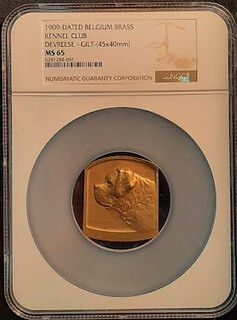 Among my first stops was Doug Winter's table, where he had a display copy of his new book on Dahlonega gold. We had a good conversation on a number of topics. While his specialty is U.S. gold, he has a soft spot for dogs and I spotted this slabbed Belgian medal in his case.
Among my first stops was Doug Winter's table, where he had a display copy of his new book on Dahlonega gold. We had a good conversation on a number of topics. While his specialty is U.S. gold, he has a soft spot for dogs and I spotted this slabbed Belgian medal in his case.
To read the earlier E-Sylum article, see:
NEW BOOK: DAHLONEGA MINT GOLD, 4TH EDITION
(https://www.coinbooks.org/v26/esylum_v26n44a03.html)
Greg Bennick
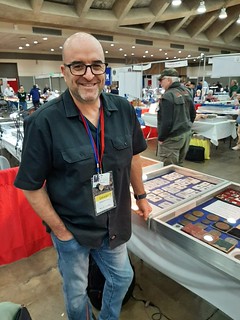 Next up was John Kraljevich's table, where I also found Greg Bennick and Erik Goldstein. I had some Newman Numismatic Portal business to discuss with Greg, and we sat down to review his notes on upcoming guests for his interview series. We spotted NNP Project Coordinator Len Augsburger across the aisle and called him over. The three of us talked about the interviews and my indirect experience with new Large Language Models for transcribing audio with high speed and accuracy. These could help speed publication of transcripts for NNP and The E-Sylum.
Next up was John Kraljevich's table, where I also found Greg Bennick and Erik Goldstein. I had some Newman Numismatic Portal business to discuss with Greg, and we sat down to review his notes on upcoming guests for his interview series. We spotted NNP Project Coordinator Len Augsburger across the aisle and called him over. The three of us talked about the interviews and my indirect experience with new Large Language Models for transcribing audio with high speed and accuracy. These could help speed publication of transcripts for NNP and The E-Sylum.
Greg reported getting great feedback from multiple parties about his interviews, and I've heard the same. Stay tuned - some more are already recorded and being processed, and several more are queued up for the coming months.
Being at JK's table at a major coin show is like standing in Times Square - sooner or later everyone in the world passes by. My apologies to our advertisers and sponsors attending the show - I usually get around to see many of them, but it wasn't in the cards this week. Here are some of the folks I talked with.
Stu Levine
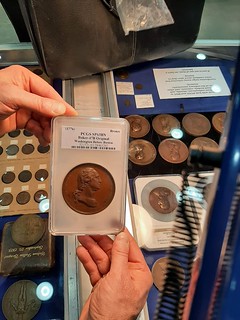 Stu Levine and I are both lending material to Washington University in St. Louis for an exhibit next year. I recently shipped some of my J.S.G. Boggs money art collection, and Stu brought some items to give Len, including this Washington medal.
Stu Levine and I are both lending material to Washington University in St. Louis for an exhibit next year. I recently shipped some of my J.S.G. Boggs money art collection, and Stu brought some items to give Len, including this Washington medal.
Stu let me know he was a purchaser of some headline lots in my recent library sale, and I thanked him on behalf of our kids' "college fund."
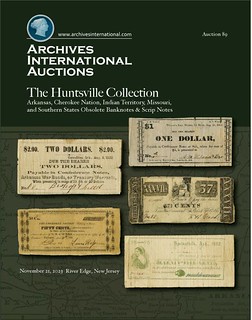 Bob Schwartz owns Archives International Auctions, was an early E-Sylum advertiser and is still a regular. He gave me a hardcopy of his current sale of the Huntsville Collection, which will be a useful reference of "Arkansas, Cherokee Nation, Indian Territory, Missouri, and Southern States Obsolete Banknotes and Scrip Notes."
Bob Schwartz owns Archives International Auctions, was an early E-Sylum advertiser and is still a regular. He gave me a hardcopy of his current sale of the Huntsville Collection, which will be a useful reference of "Arkansas, Cherokee Nation, Indian Territory, Missouri, and Southern States Obsolete Banknotes and Scrip Notes."
John Kraljevich
After all this time hanging at his table, I hadn't gotten a chance to talk to John Kraljevich yet. He was looking dapper in a sport jacket. When I asked why, he responded "interviews." He'd been doing publicity to promote the show in Baltimore newspapers and television. Here's one example.
The nice thing about coin collecting is that there's something for everybody. If you like cats, collect coins with cats on them.
If you like ancient history, do that. If you like the history of Baltimore, collect things related to Baltimore, said John Kraljevich, a senior consultant with Stacks Bowers Galleries.
Among the featured coins are some that were made in California during the gold rush, which are worth about $750,000.
To read the complete article or watch the video, see:
Collectors converge on Baltimore for Whitman Coin Expo
(https://www.wbal.com/collectors-converge-on-baltimore-for-whitman-coin-expo/)
Baltimore hosting Whitman Coin Expo
(https://www.youtube.com/watch?v=0J02SyJUngU)
WAYNE'S NUMISMATIC DIARY: NOVEMBER 12, 2023, PART 2
Taylor Swift
No, Taylor wasn't at the Whitman show, but hey, she's still single and maybe one of the unattached numismatists I know will bring her one day. Her name came up when I explained a family trip I'm planning next July. Our daughter and her best friend are Swifties and had trouble getting concert tickets. She asked if she could go to a show in Switzerland if they could get tickets. Figuring that's unlikely, I said yes. Guess what - they scored floor seats and now we've got plane tickets to Zurich.
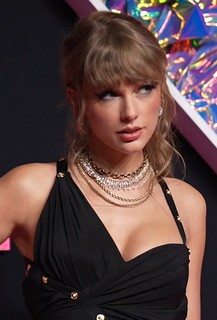 Len had great fun with that news - "flying to Zurich for a Taylor Swift concert" was absolutely the last thing he ever thought would come out of my mouth. Me too. But now we're planning a two-family trip with the two girls, two sets of parents and a brother. The ladies have the floor seats and the menfolk are in an upper section of the stadium. With a beverage in hand I expect to frame the experience as kind of like a Super Bowl, with a really long halftime show.
Len had great fun with that news - "flying to Zurich for a Taylor Swift concert" was absolutely the last thing he ever thought would come out of my mouth. Me too. But now we're planning a two-family trip with the two girls, two sets of parents and a brother. The ladies have the floor seats and the menfolk are in an upper section of the stadium. With a beverage in hand I expect to frame the experience as kind of like a Super Bowl, with a really long halftime show.
But it's a great opportunity to bond with my daughter while she's home from college for the summer. I've already shared with her a Spotify playlist of my own favorite female vocalists, and she flooded the zone by adding a bazillion Taylor Swift songs.
Meanwhile, I discovered that Taylor has at least one coin in her collection.
When Taylor Swift won her countersuit against former Colorado D.J. David Mueller, whom she had accused of groping her in a photo op, she asked Mueller to pay her a symbolic
$1. Nearly four months after this verdict, Mueller has finally paid that $1, a Sacajawea coin that he mailed to the singer on November 28, he told the Associated Press in a letter.
Who can come up with another numismatic Swift connection?
For those who've had their head in coin books too long and haven't heard of Taylor Swift, see: https://en.wikipedia.org/wiki/Taylor_Swift
To read the complete article, see:
Taylor Swift Has Finally Been Sent the Symbolic Dollar She Won in Court
(https://www.vanityfair.com/style/2017/12/former-dj-david-mueller-says-he-sent-taylor-swift-dollar-payment)
Winston Zack and Jeff Rock
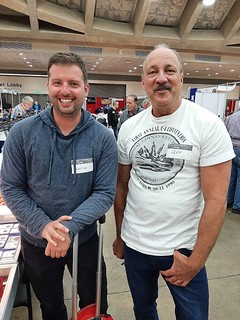 Before leaving JK's table I had a nice talk with Winston Zack and Jeff Rock
Jeff is a longtime E-Sylum contributor. Zack's specialty is contemporary counterfeit coins, and we discussed his next book project.
Before leaving JK's table I had a nice talk with Winston Zack and Jeff Rock
Jeff is a longtime E-Sylum contributor. Zack's specialty is contemporary counterfeit coins, and we discussed his next book project.
An Unusual Star Note
Later on in the afternoon I caught up again with Mike Packard back at John Kraljevich's table, and told John about my little game of "Who's the First Numismatist" I'll run into at a coin show. When I said Mike was today's "winner", John asked, "What did he win - what's the prize?" So I had to scramble and checked my wallet looking for a dollar bill I'd noticed earlier in the week. Turns out it was still at home on my scanner.
But I promised to bring it to him at our next Nummis Nova dinner - "a very unique 'star note'.
Looking at this again now, I noticed that the scribbler had also blacked out the letter "F" at the top, making this an equally unusual "EDERAL RESERVE NOTE". I also spotted a third scribble I'll leave as an exercise for readers.
Yesterday I came across another unusual 'star' note, a photo of Sotheby's London staff hanging Andy Warhol's "Silver Certificate, 1962".
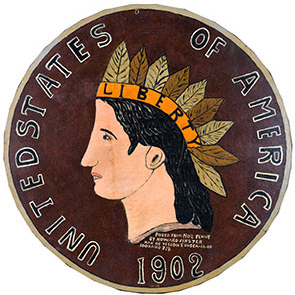 Having veered into the topic of numismatics in art, here's another work that caught my eye this week - Howard Finster's "1902 Liberty Penny" in Slotin Auction's Fall Self-Taught Art Masterpiece Sale. From: ArtDaily Newsletter: Tuesday, Nov 07, 2023.
Having veered into the topic of numismatics in art, here's another work that caught my eye this week - Howard Finster's "1902 Liberty Penny" in Slotin Auction's Fall Self-Taught Art Masterpiece Sale. From: ArtDaily Newsletter: Tuesday, Nov 07, 2023.
To read the complete articles, see:
The Hidden Costs of Working in the Art World
(https://hyperallergic.com/855272/the-hidden-costs-of-working-in-the-art-world-arttable/)
'Masterpieces' find new homes in Slotin Auction's Fall Self-Taught Sale
(https://artdaily.cc/news/163838/-Masterpieces--find-new-homes-in-Slotin-Auction-s-Fall-Self-Taught-Sale)
Closing Out the Day
I did a lot of running around toward the end of the afternoon. I stopped to say hello to literature dealer Charlie Davis who was closing up his table after a long day, then ran into Chris MacDowell who invited me to stop by the Colonial Coin Collectors Club event.
Kerry Wetterstrom and Dennis Tucker
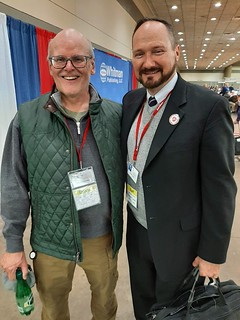 I had to beg off our conversation to catch up with Dennis Tucker, who reported that kickoff meetings with John Feigenbaum and CDN Publishing were going very well. I only saw John from a distance and didn't get a chance to speak to him, but he was understandably quite busy having just announced CDN's acquisition of the iconic Red Book publisher.
I had to beg off our conversation to catch up with Dennis Tucker, who reported that kickoff meetings with John Feigenbaum and CDN Publishing were going very well. I only saw John from a distance and didn't get a chance to speak to him, but he was understandably quite busy having just announced CDN's acquisition of the iconic Red Book publisher.
The two of us chatted with Kerry Wetterstrom on multiple topics, including other collectible fields (yes, there are people who are the Q. David Bowers of outboard motors). Retirement was another topic - I'm getting closer to retirement from my day job, and Kerry's longtime association with Classical Numismatics Group has many people thinking he still works there despite having retired two years ago.
To read the earlier E-Sylum article, see:
CDN PUBLISHING ACQUIRES WHITMAN
(https://www.coinbooks.org/v26/esylum_v26n45a09.html)
Stack's Bowers, Vicken Vegparian and Dan Freidus
Around the corner from my conversation with Kerry and Dennis was the Stack's Bowers table, where I enjoyed a look at displayed lots from future sales. Forgive the poor photos - it's always a challenge to avoid glare from overhead lighting.
At the Stack's Bowers table I spoke with Vicken Vegparian about the Indian Peace Medals and getting scans of the inventory book for the Millholland Collection, that century-old cabinet Stack's Bowers recently sold. We'll look forward to adding this to the Newman Numismatic Portal for future researchers.
Longtime NBS member Dan Freidus joined us for a bit and we learned about one of his retirement side projects - locating old Jewish cookbooks not already in the extensive collection of the New York Public Library.
Other folks I spoke to on the bourse included Julian Leidman, Terry Hess and Dan Sedwick. I also ran into or saw Bruce Smith, Dennis Hengeveld and Jeff Garrett, but didn't get a chance to talk.
After the bourse closed I looked in the show program for the location of the colonial coin group event, but couldn't find it listed anywhere. I remembered one of these being in the Sheraton hotel in the past, so I walked over there. When I saw a group of grey-haired folks hoofing it up a stalled escalator I followed them to a ballroom and recognized a number of folks including Jeff Rock and NBS Board member Roger Siboni.
I was only there to mingle and spoke briefly with Chris McCawley, Julia Casey and others before heading back out. I walked over to the Fogo de Chão restaurant where I had a relaxing dinner with Len Augsbuger and friends.
While colder weather was on the way, the evening was still warm as I headed back to my car from the restaurant. I'm glad I was able to get to the show and see so many great friends - I only wish I'd had time to do more.
Dick Johnson
At home on Friday for the Federal Veteran's Day holiday observation, I gradually caught up with some lingering to-dos cluttering my desk, and was delighted to see a group of photos Dick Johnson's widow Shirley sent me of their 2004 visit to our home in Pittsburgh. Our boys were little and our daughter had just been born. We went out to dinner at a small neighborhood restaurant and came back to show Dick my library/office, where I also shared with him how I create The E-Sylum each week. A delightful visit with the founding editor of Coin World and our most prolific contributor.
Whew. That's all for this week. Thanks for following along with my little adventures.
ANGLESEY METAL DETECTORIST INTERVIEWED
This article features a recent convert to metal detecting and some of his recent finds. -Editor
By day, marine geologist Dr Michael Roberts explores the underwater history of the Irish Sea. After work, his explorations take him underground in search of Anglesey's past.
Armed with a metal detector, his latest discovery was a medieval silver coin from the time when Wales was being shackled by King Edward I's ring of iron
. So much history, he notes, lies buried beneath our feet.
At the time the coin was minted, near Amlwch, the greatest castle never built was under construction less than 20 miles away in Beaumaris. Edward I's unfinished masterpiece was continued by his son and the coin found by Dr Roberts was made for the latter.
The Edward II silver penny is the oldest coin I've found but it might be worth only £10-£15, which is staggering considering its age,
he said. Anyone thinking that metal detecting is a quick route to finding a fortune had better get ready for disappointment. It won't make you much more than 50 pence an hour, if you're lucky.
But monetary value isn't the point. What's far more important is finding something that gives a tangible connection with the past.
As a Bangor University academic, Dr Roberts studies seascapes and shipwrecks, offering an underwater link to the maritime history of North Wales. He took up metal detecting almost exactly a year ago – his mid-range machine arrived in the post on November 19, 2022.
Almost inevitably his interest was kindled by a certain comedy show. During Covid lockdowns, he chanced on the BBC's Detectorists. I was inspired by seeing a group of normal people struggling to find something of value in beautiful countryside when not realising they'd already found something money could not buy,
he said.
To read the complete article, see:
'Ring of steel' conquest coin among detectorist's incredible hoard on Anglesey
(https://www.dailypost.co.uk/news/north-wales-news/ring-steel-conquest-coin-among-28084596)
DEALER WHO EXPOSED BRITISH MUSEUM THEFTS
The Wall Street Journal published a nice article and interview with the Dutch dealer credited with exposing the theft of coins and gems by a British Museum curator. Here's an excerpt. -Editor
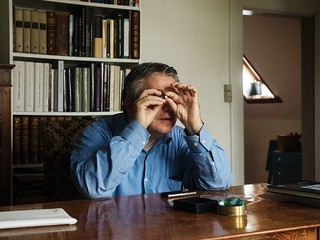 ITTAI GRADEL, an academic–turned–gem dealer in Denmark, was trawling eBay a decade ago when he thought he had stumbled across a gold mine.
ITTAI GRADEL, an academic–turned–gem dealer in Denmark, was trawling eBay a decade ago when he thought he had stumbled across a gold mine.
On his screen, Gradel saw a seller called Sultan1966 advertising a glass gem from the 19th century. Gradel immediately recognized it as something much more valuable: an agate Roman Medusa cameo from the second century, featuring the mythical Gorgon with snakes as hair. He snapped it up for £15 plus postage, then turned around and sold it to a collector for a couple of thousand pounds.
In the following years, Sultan1966 kept unearthing incredible finds at rock-bottom prices. Gradel bought a ring for £150, which he assumed was a copy of one from the Ptolemaic kingdom, an ancient Greco-Egyptian empire. But when he received the item and verified it was an original from over 2,000 years ago, Gradel told Sultan1966 he had mispriced his ring and sent him an extra £500. It was ridiculous,
he remembers thinking.
Gradel inquired as to how the seller, an Englishman whose name was listed as Paul Higgins, had come across these items. Sultan1966 said he had acquired them from his grandfather, who owned a junk shop in York, in northern England, and died in 1953. Gradel checked the death records and found that such a man with the matching name did indeed die, but in 1952. The ludicrously low prices and oddly credible backstory left Gradel comfortable that he had encountered every dealer's dream seller. He was clueless,
recalls Gradel.
Then, in 2016, Sultan1966 posted a piece on eBay by mistake. It showed a fragment of a sardonyx cameo dating from Roman times engraved with the head and shoulder of a girl stooping to her right. Intrigued, Gradel screenshotted the item. Sultan1966 quickly removed it from the website and said that it actually belonged to his sister, who didn't want to sell it.
Gradel thought not much more about it. But in 2020, he came across an image on the British Museum's website that showed the exact same item in its collection. Furthermore, the color photograph was recent. It suddenly dawned on Gradel: There was a thief in the British Museum. And he was likely still within the walls,
he says.
So began an antiques whodunit—whose cast of characters includes an Oxford-based priest-cum-archaeologist, a handful of rare-gem dealers and some of the British Museum's most august researchers—that has shaken the premise behind the museum's most important reason for existing: that it is the best place to safely house some of the world's greatest treasures.
Bibliophiles will appreciate how an old catalog assisted the investigation. -Editor
Gradel has one major advantage over fellow dealers: a photographic memory. Peter Szuhay, a London-based dealer who has known Gradel for over a decade, says Gradel has memorized which hairstyles ancient Romans wore in different years, a skill that helps him to accurately date portraits carved into gems. No other dealer would have caught the thief,
Szuhay says.
A while after, Gradel read a book by a Polish gem specialist that featured an image of a stone from a 1926 British Museum catalog blown up on a large scale. I thought that looked familiar,
he recalled thinking. There, in the book, was the gem with the same Roman profile and the same distinctive hairstyle. That, along with a couple of tiny scratches on the man's nasal ridge, matched exactly the piece Gradel received a year earlier. Clearly, Gradel concluded, they were the same piece.
To read the complete article or listen to a podcast (subscription required), see:
How an Academic Uncovered One of the Biggest Museum Heists of All Time
(https://www.wsj.com/style/british-museum-ittai-gradel-heist-efec0847)
How an Antiques Dealer Uncovered a Massive Museum Heist
(https://www.wsj.com/podcasts/the-journal/how-an-antiques-dealer-uncovered-a-massive-museum-heist/86787c96-18a8-4b5b-ba06-e55a20cd7b9c)
To read the earlier E-Sylum articles, see:
BRITISH MUSEUM GRAPPLES WITH THEFTS
(https://www.coinbooks.org/v26/esylum_v26n35a23.html)
MARK JONES NAMED INTERIM BRITISH MUSEUM DIRECTOR
(https://www.coinbooks.org/v26/esylum_v26n36a14.html)
BRITISH MUSEUM SEEKS RECOVERY OF STOLEN ITEMS
(https://www.coinbooks.org/v26/esylum_v26n41a29.html)
LOOSE CHANGE: NOVEMBER 12, 2023
Here are some additional items in the media this week that may be of interest. -Editor
A commentary by Ursula Kampmann of CoinsWeekly provides a European perspective on the recent acquisition of Whitman Publishing by CDN Publishing. -Editor
To read the complete article, see:
CDN Acquires Whitman: What Does This Mean for the Coin Market?
(https://new.coinsweekly.com/news-en/cdn-acquires-whitman-what-does-this-mean-for-the-coin-market/)
To read the earlier E-Sylum article, see:
CDN PUBLISHING ACQUIRES WHITMAN
(https://www.coinbooks.org/v26/esylum_v26n45a09.html)
Dick Hanscom passed along this video of Bolivia's mountain of silver - Potosi. Thanks. -Editor
Why 'the mountain that eats men' is on the verge of collapse in Bolivia
Miners in Bolivia spend hours searching for silver, tin, and zinc inside Cerro Rico, a 15,000-foot mountain that used to be the world's largest source of silver. But little has changed for miners since colonial times, with thousands putting their lives at risk inside mines that could collapse at any moment.
To watch the complete video, see:
(https://www.msn.com/en-us/video/peopleandplaces/why-the-mountain-that-eats-men-is-on-the-verge-of-collapse-in-bolivia/vi-AA1jJ2Fs)
Some of the infamous hijacker "D. B. Cooper"'s ransom cash was found many years later, fueling numismatic interest in the unsolved case. A new book reviewed in the Wall Street Journal looks at the burst in air piracy following that enigmatic heist. -Editor
D.B. Cooper belongs in the pantheon of American desperados—a Jesse James or Billy the Kid for our times.
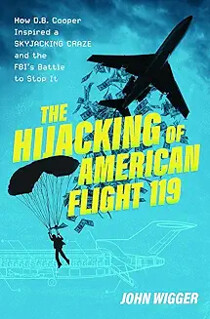 On Nov. 24, 1971, Cooper hijacked a Northwest Orient Airlines Boeing 727 as it was en route to Seattle. He threatened to blow up the plane with a homemade bomb, and he demanded $200,000 and four parachutes. Once the loot and gear were delivered on the tarmac in Seattle, Cooper directed the pilots to fly to Mexico. The refueled jet headed south. Over the Cascade mountain range, Cooper jumped from the plane's rear-exit stairway, the cash in a bag tied to his body. Years later, some of the money turned up half-buried in the wilderness—but no trace of Cooper has ever been found.
On Nov. 24, 1971, Cooper hijacked a Northwest Orient Airlines Boeing 727 as it was en route to Seattle. He threatened to blow up the plane with a homemade bomb, and he demanded $200,000 and four parachutes. Once the loot and gear were delivered on the tarmac in Seattle, Cooper directed the pilots to fly to Mexico. The refueled jet headed south. Over the Cascade mountain range, Cooper jumped from the plane's rear-exit stairway, the cash in a bag tied to his body. Years later, some of the money turned up half-buried in the wilderness—but no trace of Cooper has ever been found.
An artist's rendering of Cooper in his shiny wraparound sunglasses quickly became a pop icon. The skyjacker also triggered a run of bizarre copycat crimes. Now John Wigger, a history professor at the University of Missouri, has reconstructed Cooper's story, among others, in The Hijacking of American Flight 119: How D.B. Cooper Inspired a Skyjacking Craze and the FBI's Battle to Stop It.
Meticulously reported, the book belongs on the shelf with other pop histories of the febrile last decades of the 20th century in America.
To read the complete article, see:
‘The Hijacking of American Flight 119' Review: Take the Money and Jump
(https://www.wsj.com/arts-culture/books/the-hijacking-of-american-flight-119-review-take-the-money-and-jump-26189aea)
To read an earlier E-Sylum article, see:
NEW DEVELOPMENT IN D. B. COOPER CASE CLAIMED
(https://coinbooks.org/v21/esylum_v21n05a38.html)


